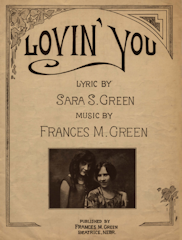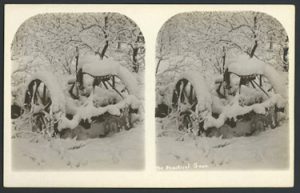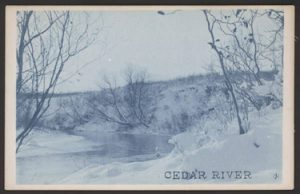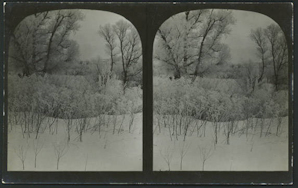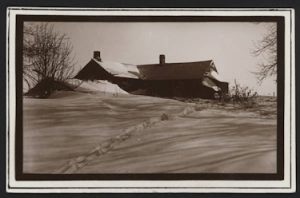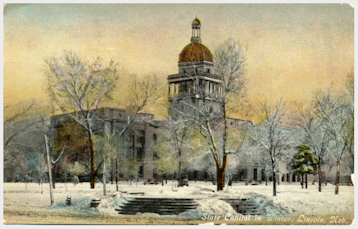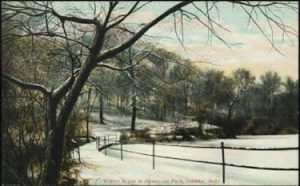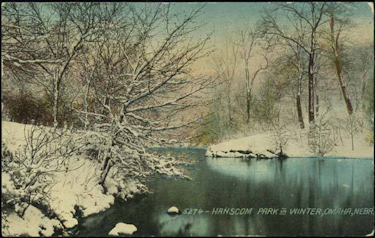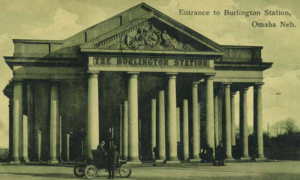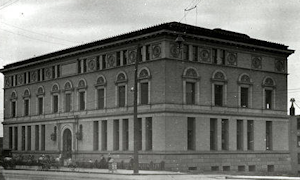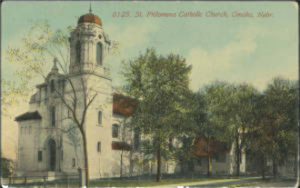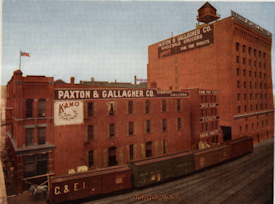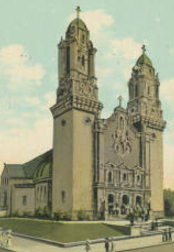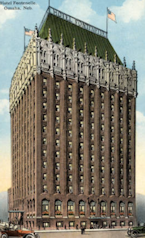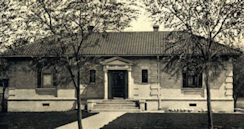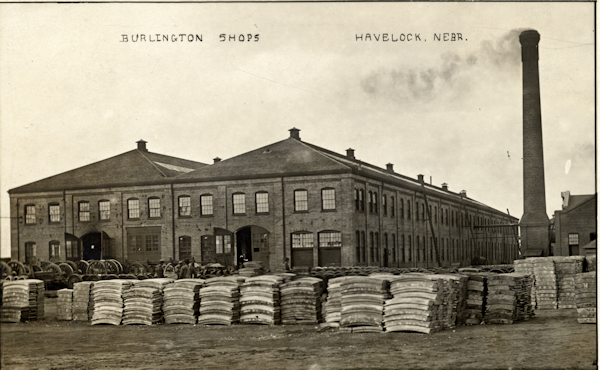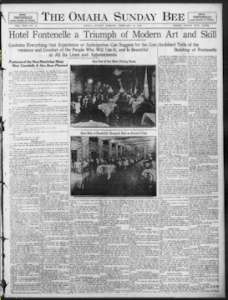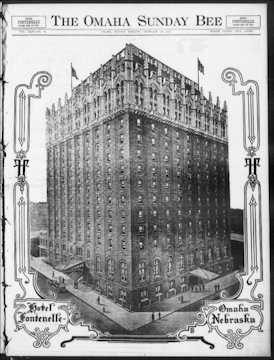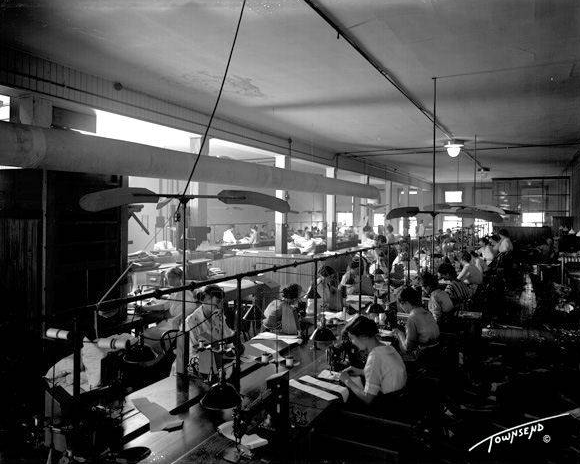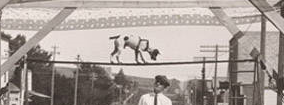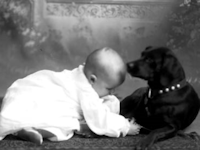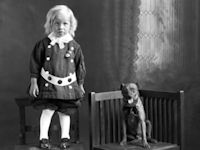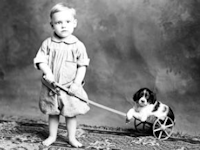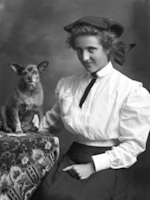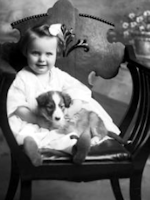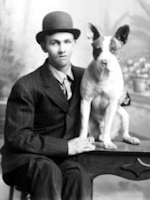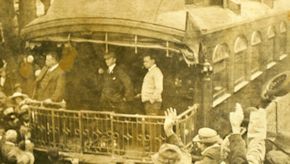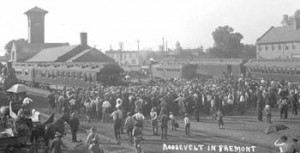Search the Blog
Categories
- Books & Reading
- Broadband Buzz
- Census
- Education & Training
- Friday Reads
- General
- Grants
- Information Resources
- Library Management
- Nebraska Center for the Book
- Nebraska Libraries on the Web
- Nebraska Memories
- Now hiring @ your library
- Preservation
- Pretty Sweet Tech
- Programming
- Public Library Boards of Trustees
- Public Relations
- Talking Book & Braille Service (TBBS)
- Technology
- Uncategorized
- What's Up Doc / Govdocs
- Youth Services
Archives
Subscribe
Author Archives: Allana Novotny
Seed Companies
A few weeks ago, I had a conversation with a librarian about old seed catalogs. I must admit that before the conversation I’d never thought about seed companies or their catalogs. I’d seen photos of seed companies in Nebraska Memories and I thought their main business would have been selling corn, wheat or other seeds that farmers needed along with some basic seeds for the garden.
Because of that conversation, I found the US Department of Agricultural Library’s Henry G. Gilbert Nursery and Seed Trade Catalog Collection. The collection contains over 200,000 items and currently 41,683 of them have been digitized and made available through the Internet Archives. In the digitized collection, I found 644 seed catalogs or price lists from Nebraska including items for all three seed stores pictured in Nebraska 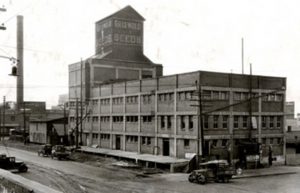 Memories. After looking at these catalogs, I realized that these seed companies sold a lot more than seed corn. Let me share with you what I learned about these three stores.
Memories. After looking at these catalogs, I realized that these seed companies sold a lot more than seed corn. Let me share with you what I learned about these three stores.
Griswold Seed and Nursery Company
This photo from 1928 is of the Griswold Seed and Nursery Company’s elevator and warehouse. This warehouse was built in 1910 at the corner of 8th and N Street in downtown Lincoln. In 1994, the building was sold to the Midwest Steel Company. As you can see in Google Street View, the building is still being used today.
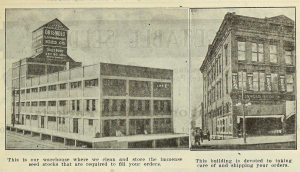 I found 27 catalogs from the Griswold Company in the US Dept. of Ag collection. Looking through the catalogs, I learned that the company was started in 1891. The image to the left is from the 1916 catalog and shows the elevator and warehouse and their retail store that was located at 147 S 10th St. If you are familiar with Lincoln, this is the address of the parking lot next to the Terminal Building. On this same page of the catalog, they
I found 27 catalogs from the Griswold Company in the US Dept. of Ag collection. Looking through the catalogs, I learned that the company was started in 1891. The image to the left is from the 1916 catalog and shows the elevator and warehouse and their retail store that was located at 147 S 10th St. If you are familiar with Lincoln, this is the address of the parking lot next to the Terminal Building. On this same page of the catalog, they 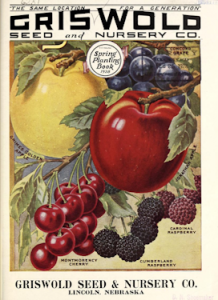 mention that their name is now Griswold Seed & Nursery Co. Previously it was just the Griswold Seed Co.
mention that their name is now Griswold Seed & Nursery Co. Previously it was just the Griswold Seed Co.
The photo of the Griswold elevator and warehouse was taken in 1928 so I looked at the Griswold Seed & Nursery Co. Spring 1928 catalog. The catalog has 92 pages. The front cover shows a couple of varieties of apples and berries. Looking at the index, I’m guessing there are over 400 items listed including a variety of flowers, vegetables, trees and bushes. I checked and they did sell field corn, wheat and sugar beets.
Gunn Seed Company View 1 and View 2
 The Gunn Seed Company was located at 219 S. 10th Street in Lincoln. This was just down the block from the Griswold retail store. That location is also currently a parking lot. If you take the time to look at the photos of the Gunn Seed Company, it is obvious that they sell a variety of items. The smaller sign above the door says Gunn Seed Co. Poultry Supplies. The larger sign mentions Field, Garden, Flower Seeds on one side and Poultry Supplies / Garden Tools on other. On the sidewalk in front of the store is a collection of plants, gardening tools and bags of feed.
The Gunn Seed Company was located at 219 S. 10th Street in Lincoln. This was just down the block from the Griswold retail store. That location is also currently a parking lot. If you take the time to look at the photos of the Gunn Seed Company, it is obvious that they sell a variety of items. The smaller sign above the door says Gunn Seed Co. Poultry Supplies. The larger sign mentions Field, Garden, Flower Seeds on one side and Poultry Supplies / Garden Tools on other. On the sidewalk in front of the store is a collection of plants, gardening tools and bags of feed.
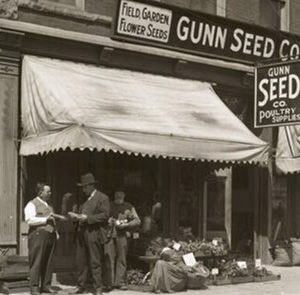 There are 10 documents from the Gunn Seed Company included in the US Dept. of Ag collection. Like the Griswold Seed Company, Gunn sold a variety of vegetable and flower seeds. They also offered a wide variety of poultry supplies.
There are 10 documents from the Gunn Seed Company included in the US Dept. of Ag collection. Like the Griswold Seed Company, Gunn sold a variety of vegetable and flower seeds. They also offered a wide variety of poultry supplies.
Both photos of the Gunn Seed Company were taken in 1916. Their first catalog available in the collection 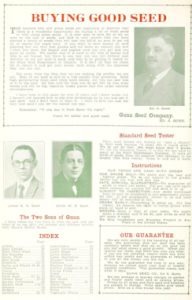 is from 1919. I’m not sure when the Gunn store first opened. I looked in the 1908 city directory and did not find the Gunn Seed store listed but I did find an entry for Gunn, Edwin S. who was listed as the “mngr retail dept Griswold Seed Co.”. I looked through all of the Gunn seed catalogs and in every one of them is a picture of Ed. S. Gunn. My guess is that Edwin left Griswold Seed and started his own company but I wasn’t able to find any documentation that confirmed this.
is from 1919. I’m not sure when the Gunn store first opened. I looked in the 1908 city directory and did not find the Gunn Seed store listed but I did find an entry for Gunn, Edwin S. who was listed as the “mngr retail dept Griswold Seed Co.”. I looked through all of the Gunn seed catalogs and in every one of them is a picture of Ed. S. Gunn. My guess is that Edwin left Griswold Seed and started his own company but I wasn’t able to find any documentation that confirmed this.
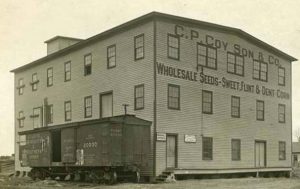 This photo of the C. P. Coy & Co. building located in Valley was taken around 1910. We don’t know the exact date of the photo was taken. We do know that it was built in 1903. My search of the US Dept. of Ag’s collection for Coy was successful as I found 16 different seed price lists. As I started looking at them, I realized there were two companies with similar names. There were seven prices lists from Chauncey P. Coy and Son. This name matches the name on side of the building. The dates of the price lists range from 1901 to 1926. The address listed on all of these price lists is Waterloo, NE however. The two names listed in the 1902 booklet were C. P. Coy and H. G. Coy.
This photo of the C. P. Coy & Co. building located in Valley was taken around 1910. We don’t know the exact date of the photo was taken. We do know that it was built in 1903. My search of the US Dept. of Ag’s collection for Coy was successful as I found 16 different seed price lists. As I started looking at them, I realized there were two companies with similar names. There were seven prices lists from Chauncey P. Coy and Son. This name matches the name on side of the building. The dates of the price lists range from 1901 to 1926. The address listed on all of these price lists is Waterloo, NE however. The two names listed in the 1902 booklet were C. P. Coy and H. G. Coy.
The other nine price lists are from the C. Herbert Coy Seed Co. of Valley. They range from 1916 to 1926. The 1915 catalog has a picture of the same building that is in Nebraska Memories. The name on the building is now C. Herbert Coy Seed Co.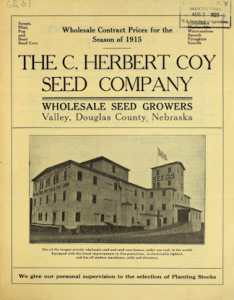
At first, I thought C. Herbert might be the son but the names didn’t match up. I found more information about C. Herbert in the 1917 book Omaha: The Gate City, and Douglas County, Nebraska, Volume 2. In the short bio about him, it states that he moved to Valley from New York in 1901 to start his company. There is no reference to him having family in Waterloo. According to a family tree created by a distant Coy relative that I found in the MyHeritage Library Edition database Chauncey P. Coy would have been Charles Herbert Coy’s uncle.
Both the Coy companies were wholesale seed growers. Their price sheets were set up to sell seed by the pound. They offered a limited selection of seeds including cucumbers, melons, gourds, and corn.
I hope you enjoyed learning a little bit about these three seed companies. Visit Nebraska Memories to search for or browse through many more historical images digitized from photographs, negatives, postcards, maps, lantern slides, books and other materials.
Nebraska Memories is a cooperative project to digitize Nebraska-related historical and cultural heritage materials and make them available to researchers of all ages via the Internet. Nebraska Memories is brought to you by the Nebraska Library Commission. If your institution is interested in participating in Nebraska Memories, see http://nlc.nebraska.gov/nebraskamemories/participation.aspx for more information, contact Devra Dragos, Technology & Access Services Director.
Posted in Nebraska Memories
1 Comment
Past Legislators
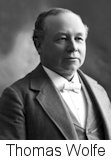 With the 2018 Primary Elections being held last week I thought it would be a good time to highlight a few former legislators whose photos are included in Nebraska Memories. When Nebraska became a state in 1867 it had both a Senate and House of Representatives. The four men whose photos appear in Nebraska Memories were all members of Nebraska’s House of Representatives.
With the 2018 Primary Elections being held last week I thought it would be a good time to highlight a few former legislators whose photos are included in Nebraska Memories. When Nebraska became a state in 1867 it had both a Senate and House of Representatives. The four men whose photos appear in Nebraska Memories were all members of Nebraska’s House of Representatives.
Thomas Wolfe (1877-1879)
Thomas Wolfe was born 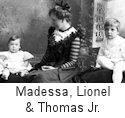 in Germany in 1847. His family moved to Wisconsin shortly after his birth. He worked at a variety of newspapers including the Tribune in Chicago, the Evening
in Germany in 1847. His family moved to Wisconsin shortly after his birth. He worked at a variety of newspapers including the Tribune in Chicago, the Evening  Post in New York, the Republican and the Bee in Omaha, and the Nebraska Reporter in Seward. In 1877 became president of the Butler County bank in David City.
Post in New York, the Republican and the Bee in Omaha, and the Nebraska Reporter in Seward. In 1877 became president of the Butler County bank in David City.
Thomas Wolfe was a member of the Nebraska House of Representatives from 1877 to 1879 representing Seward County. Thomas also served as the president of the Nebraska Press Association from 1879-1880. Thomas and his wife Madessa had three children Leonel, Thomas Jr. and Medessa.
Matt Miller (1885-1889)
 Mat Miller was born in Scotland in 1850. He immigrated with his family to Wisconsin when he was two years old. Both of his parents died when he was eight leaving him and his three siblings as orphans. At the page of 14, Matt ran away an
Mat Miller was born in Scotland in 1850. He immigrated with his family to Wisconsin when he was two years old. Both of his parents died when he was eight leaving him and his three siblings as orphans. At the page of 14, Matt ran away an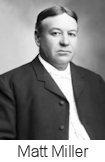 d enlisted in the Union Army. He was discharged in 1866 and after completing high school and graduating commercial college, he moved to Burt County Nebraska.
d enlisted in the Union Army. He was discharged in 1866 and after completing high school and graduating commercial college, he moved to Burt County Nebraska.
In 1879, Matt and his first wife Sarah moved to Schuyler and a year later Matt was admitted to the bar. In 1881, he moved to David City and practiced law in town for 42 years. Matt was elected to the House of Representatives and served from 1885 to 1889. Matt also went on to serve as judge for District 5 in Nebraska from 1891-1892.
Michael Delaney (1889-1891 & 1895-1897)
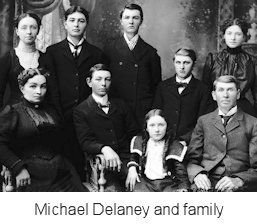 Michael Delaney was born in 1843 in New York. When he was two, his parents moved to Wisconsin. He later moved to Iowa where he was a teacher and a farmer. In 1872, he purchased a farm in Butler County Nebraska. In addition to serving as a member of the House or Representatives from 1889-1891 and 1895-1897 Michael held numerous other positions. Some of the positions he held included county superintendent of schools, school director for his district, a member of the Board of Supervisors and Justice of the Peace. Michael and his wife Katherine had seven children.
Michael Delaney was born in 1843 in New York. When he was two, his parents moved to Wisconsin. He later moved to Iowa where he was a teacher and a farmer. In 1872, he purchased a farm in Butler County Nebraska. In addition to serving as a member of the House or Representatives from 1889-1891 and 1895-1897 Michael held numerous other positions. Some of the positions he held included county superintendent of schools, school director for his district, a member of the Board of Supervisors and Justice of the Peace. Michael and his wife Katherine had seven children.
Henry C. Richmond (1915-1917)
Henry C. Richmond was born in 1870 in Missouri. As a child, his family moved to Kansas and later to Webster County Nebraska. Henry worked at a number of newspapers 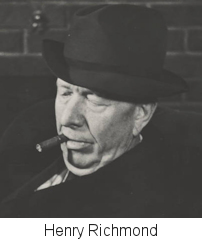 including the Red Cloud Chief, Omaha World-Herald, and the Fremont Daily Herald. In 1907, he was elected president of the Nebraska Press Association. In 1911 and again in 1913 Henry was elected chief clerk of the Nebraska House of Representatives.
including the Red Cloud Chief, Omaha World-Herald, and the Fremont Daily Herald. In 1907, he was elected president of the Nebraska Press Association. In 1911 and again in 1913 Henry was elected chief clerk of the Nebraska House of Representatives.
Henry Richmond served as a member of the House of Representatives from 1915-1917 representing Douglas County. Following his term in 1917, he became the secretary for the Nebraska State Council of Defense. Henry passed away in May 1945 in Portland Oregon. According to his obituary, he and his wife Jeannette had two daughters and three grandchildren.
Visit Nebraska Memories to search for or browse through many more historical images digitized from photographs, negatives, postcards, maps, lantern slides, books and other materials.
Nebraska Memories is a cooperative project to digitize Nebraska-related historical and cultural heritage materials and make them available to researchers of all ages via the Internet. Nebraska Memories is brought to you by the Nebraska Library Commission. If your institution is interested in participating in Nebraska Memories, see http://nlc.nebraska.gov/nebraskamemories/participation.aspx for more information, contact Devra Dragos, Technology & Access Services Director.
Posted in Nebraska Memories
Leave a comment
Scores of Love
Are you still looking for a unique way to express your love to a special someone today? Can you sing, play the piano and/or play the ukulele? If you answered yes, I have a few scores for you. One of the participants in Nebraska Memories is the Polley Music Library. Included in their collection are 256 musical scores. The complete scores are available so if you have the skills you can perform one these love songs for your special someone.
- Written by Sara S. Green and Frances M. Green of Beatrice, Nebraska.
- First line of the chorus: “Lovin’ you, that’s all I do”
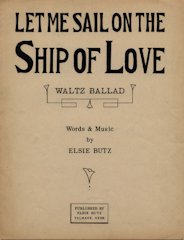 Let me sail on the ship of love
Let me sail on the ship of love
- Written by Elsie Butz of Talmage, Nebraska.
- Chorus:
“Let me sail on the ship of love,
And dream the whole time thru,
Let me sail on the ship of love,
‘Way from all trouble too,
Where there is no cloud or sorrow
Only ones you have to borrow,
Let me sail on the ship of love,
With dreams of love and you.”
- Written by Edith Louise Neumann and Carleton Everett Knox of Wymore, Neb.
- First line: “My faith in you clear heart is fixed”
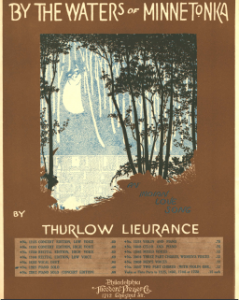 By the waters of Minnetonka: an Indian love song
By the waters of Minnetonka: an Indian love song
- The sheet music was written by Thurlow Lieurance who was a facility member at the University School of Music, Lincoln, Nebraska.
- This version of the song does not including lyrics.
- You can also listen to this song being played on the piano.
Sweet memories of love : a beautiful song
- Written by Louis Chobar while he was serving time in a Nebraska prison for a murder conviction.
- First line: “Years slowly pass since we parted”
- This piece includes an arrangement for the ukulele.
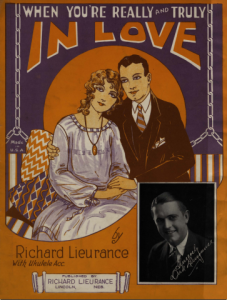 When you’re really and truly in love
When you’re really and truly in love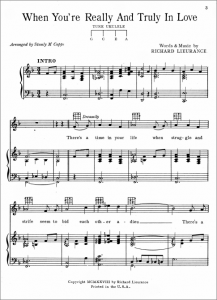
- Written by Richard Lieurance.
- First line: “There’s a time in your life when struggle and strife seem to bed each other adieu.”
- This piece includes an arrangement for the ukulele.
- This score contains two songs, Cupid’s Calendar and Sweetheart.
- Written by J. A. Parks
- Here are the lyrics for Cupid’s Calendar:
“When I’m with you, dearest one, the hours as minutes fly,
And Love cheats Time so sweetly, that his calendar’s awry;
But Cupid finds an easy way, to set the time-card true,
For minutes drag to hours, dear heart, when I’m away from you!”
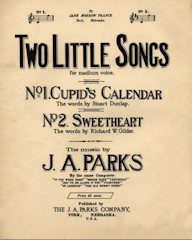
Happy Valentine’s Day everyone!
Visit Nebraska Memories to search for or browse through many more historical images digitized from photographs, negatives, postcards, maps, lantern slides, books and other materials.
Nebraska Memories is a cooperative project to digitize Nebraska-related historical and cultural heritage materials and make them available to researchers of all ages via the Internet. Nebraska Memories is brought to you by the Nebraska Library Commission. If your institution is interested in participating in Nebraska Memories, see http://nlc.nebraska.gov/nebraskamemories/participation.aspx for more information, contact Devra Dragos, Technology & Access Services Director.
Posted in Nebraska Memories
Leave a comment
Beautiful Snow
After the recent snowstorm, I saw many beautiful pictures of the snow. The pictures were taken by both friends and strangers from across Nebraska. Some were taken to show the amount of snow received while others were taken to show nature’s beauty. As I was looking at the images in Nebraska Memories today, I noticed a number of similar images of snow taken 100+ years ago. Here are a few of my favorites.
The first four photos in this post were taken by John Nelson. John Nelson was born in Sweden and moved to Wheeler County Nebraska with his parents when he was a young man. Eventually he opened a photography studio in Ericson Nebraska. While we don’t know the exact dates these photos were taken, we believe they were taken sometime between 1907 and 1918.
The above stereoscopic photograph shows antique farm machinery covered in snow. On the right image, in the bottom left corner, someone wrote “The Beautiful Snow”.
The next photo shows the banks of the Cedar River covered in snow. The Cedar River is a long winding river that starts in northern Nebraska, goes by Ericson, and finally joins the Loup River west of Fullerton, NE.
The second stereoscopic photograph shows snow covered trees and field. Images like this are timeless. It’s easy to imagine someone taking a photo like this during the last snowstorm.
The fourth picture shows Nels and Bengta Nelson’s farmhouse. They were John Nelson’s parents. The snowdrifts look large and the tracks in the snow look deep.
Photos of two other buildings caught my attention. This photo of the Clarkson Hospital in Omaha from the early 1900’s shows a portion of 21st Street in Omaha. The street looks to be snow packed and a little rough. I don’t think it would be a fun street to drive down.
I was surprised when I first saw this postcard of the Nebraska State Capitol in winter. This was the first time I’d seen a postcard of the second capitol with snow on the ground.
While the capitol may look nice surrounded by snow not everyone was impressed with the building. This postcard was never mailed but someone did write a note on the back. Here are their thoughts on the building. “This is an old “ramshackle” place surrounding by a park as shown in picture.” The person’s description of the building was probably correct. Construction on this capitol was completed in 1888 however, the construction was supposed to have been poor. In 1919, the Legislatures passed a bill providing for the construction of a new capitol that still stands today.
The last three images I would like to highlight are postcards of Hanscom Park in Omaha. Hanscom Park is located about a block west of Interstate 480 and the Martha Street exit. The land for the park was donated in 1872 and was improved in 1889. The park appears to have been a popular spot or at least a popular spot to take photographs. There are 30+ images on Hanscom Park in Nebraska Memories.
Visit Nebraska Memories to search for or browse through many more historical images digitized from photographs, negatives, postcards, maps, lantern slides, books and other materials.
Nebraska Memories is a cooperative project to digitize Nebraska-related historical and cultural heritage materials and make them available to researchers of all ages via the Internet. Nebraska Memories is brought to you by the Nebraska Library Commission. If your institution is interested in participating in Nebraska Memories, see http://nlc.nebraska.gov/nebraskamemories/participation.aspx for more information, contact Devra Dragos, Technology & Access Services Director.
Posted in Nebraska Memories
1 Comment
Looking at the Postmarks
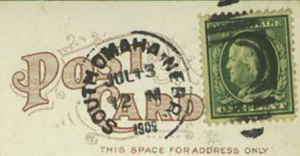 There are over 1,000 postcards in Nebraska Memories and many of them include images of both the front and backs of the cards. I’ve always found it entertaining to read the messages written on the postcards. It wasn’t until the past year or so that I started to really pay attention to the postmarks on the cards. I’ve always looked at the postmark to see what year the card was sent but the postmarks can provide additional information.
There are over 1,000 postcards in Nebraska Memories and many of them include images of both the front and backs of the cards. I’ve always found it entertaining to read the messages written on the postcards. It wasn’t until the past year or so that I started to really pay attention to the postmarks on the cards. I’ve always looked at the postmark to see what year the card was sent but the postmarks can provide additional information.
Let’s start with the basics first. Most, if not all of the postmarks that I’ve looked at in Nebraska Memories include the day, month, year and time of day along with the name of the town. The postmark above is on the back of a postcard of the Hanson’s Café. You can see that it was postmarked on July 13, 1909 at 12 midnight. This card was sent from South Omaha, Nebraska. In 1909, South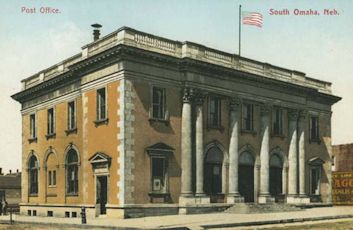 Omaha was its own town. South Omaha was annexed by Omaha in 1915. On a side note, I always like it when I can connect unrelated items in Nebraska Memories to each other. In this case, there is a postcard of the South Omaha Post Office in the collection. The post office building was completed in 1899 so it’s possible that the postcard of Hanson’s Café passed through that building. The post office building is still being used as a post office today.
Omaha was its own town. South Omaha was annexed by Omaha in 1915. On a side note, I always like it when I can connect unrelated items in Nebraska Memories to each other. In this case, there is a postcard of the South Omaha Post Office in the collection. The post office building was completed in 1899 so it’s possible that the postcard of Hanson’s Café passed through that building. The post office building is still being used as a post office today.
 Some postmarks contain more information. The image on the left is the postmark on the back of the Omaha Boulevard, South West, Omaha, Nebraska card. Do you see where it says Union Depot Postal Site? I think the last word is “site” it is hard to read. I’m assuming that means the card was cancelled at the Union Depot.
Some postmarks contain more information. The image on the left is the postmark on the back of the Omaha Boulevard, South West, Omaha, Nebraska card. Do you see where it says Union Depot Postal Site? I think the last word is “site” it is hard to read. I’m assuming that means the card was cancelled at the Union Depot.
 This postcard of the state capitol at night was postmarked On Mary 14, 1912 at Station C in Lincoln. I know Station C doesn’t mean a lot on its own but I checked a few of my favorite research sources and found just what I was looking for in the 1918 Lincoln City Directory.
This postcard of the state capitol at night was postmarked On Mary 14, 1912 at Station C in Lincoln. I know Station C doesn’t mean a lot on its own but I checked a few of my favorite research sources and found just what I was looking for in the 1918 Lincoln City Directory. 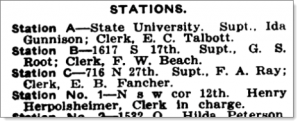 Page 49 in the book provides a wealth of information about the post offices in Lincoln. The book provides the location of the main Lincoln post office plus the locations of stations A, B, C and 1-7. According to this information, Station C was located at 716 N 27th street. That’s about at the corner of 27th and Vine Street.
Page 49 in the book provides a wealth of information about the post offices in Lincoln. The book provides the location of the main Lincoln post office plus the locations of stations A, B, C and 1-7. According to this information, Station C was located at 716 N 27th street. That’s about at the corner of 27th and Vine Street.
 Another interesting postmark I ran across was the received postmark. It appears that some items were marked as received when they reached their destination. I was curious to see how long it took a postcard to reach its destination in the late 1900’s so
Another interesting postmark I ran across was the received postmark. It appears that some items were marked as received when they reached their destination. I was curious to see how long it took a postcard to reach its destination in the late 1900’s so 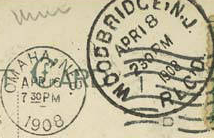 I put together the chart below. It shows the date, time and location of both postmarks. For the last column, I wanted a general idea of the distance between the two locations so I used a map to find the shortest distance. I was surprised to see how quickly the cards reached their destination. (Click on the town names listed in the Mailed From column to see the postcards.)
I put together the chart below. It shows the date, time and location of both postmarks. For the last column, I wanted a general idea of the distance between the two locations so I used a map to find the shortest distance. I was surprised to see how quickly the cards reached their destination. (Click on the town names listed in the Mailed From column to see the postcards.)
| Mailed From | Postmark Sent | Mailed To | Postmark Received | Miles between |
| Hastings | Feb 24, 1908 at midnight | Kearney | Feb 24, 1908 at 6:00 AM | 57 |
| Lincoln | Feb 21, 1908 at 8:00 AM | Hastings | Feb 21, 1908 at 4:00 PM | 108 |
| Lincoln | Sep 10, 1907 at 8:00 AM | Moulton, IA | Sep 11, 1907 at 7:00 AM | 282 |
| Omaha | Feb 12, 1907 at 4:30 PM | Corning, IA | Feb 13, 1907 at 7:00 AM | 80 |
| Omaha | May 13, 1905 at 7:00 AM | Union City, MI | May 15, 1905 at 8:00 AM | 623 |
| Omaha | Apr 16, 1908 at 7:30 PM | Woodbridge, NJ | April 18, 1908 at 2:30 PM | 1,251 |
| Scottsbluff | Jun 23, 1906 at 5:00 PM | Omaha | Jun 24, 1906 at 7:00 AM | 451 |
| Scribner | Aug 16, 1907 at 8:00 AM | Ansley | Aug 17, 1907 at 7:00 AM | 170 |
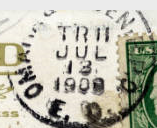 The last type of postmark I want to highlight is the RPO postmark. RPO stands for Railway Post Office. I didn’t know anything about RPO until I started doing some research for this blog post. I learned that mail clerks road on the train and sorted the mail as they went and it was a dangerous job. If you would like to know more about railway mail service, the Smithsonian provides a great history of the service.
The last type of postmark I want to highlight is the RPO postmark. RPO stands for Railway Post Office. I didn’t know anything about RPO until I started doing some research for this blog post. I learned that mail clerks road on the train and sorted the mail as they went and it was a dangerous job. If you would like to know more about railway mail service, the Smithsonian provides a great history of the service.
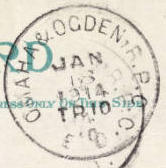 There are two postcards in Nebraska Memories that have RPO postmarks. They are both for the Omaha & Ogden (Utah) route. The postmarks contain the date and time information along with one unique piece of information. The postmarks also include the train number. An article in the Jan 1909 edition of the Omaha Bee
There are two postcards in Nebraska Memories that have RPO postmarks. They are both for the Omaha & Ogden (Utah) route. The postmarks contain the date and time information along with one unique piece of information. The postmarks also include the train number. An article in the Jan 1909 edition of the Omaha Bee talks about how the increase in mail required more clerks on the railroad lines west of the Missouri river. To the left is first paragraph of the article that talks about the Omaha & Ogden route.
talks about how the increase in mail required more clerks on the railroad lines west of the Missouri river. To the left is first paragraph of the article that talks about the Omaha & Ogden route.
I hope you enjoyed learning about a few of the different postmarks. Visit Nebraska Memories to search for or browse through many more historical images digitized from photographs, negatives, postcards, maps, lantern slides, books and other materials.
Nebraska Memories is a cooperative project to digitize Nebraska-related historical and cultural heritage materials and make them available to researchers of all ages via the Internet. Nebraska Memories is brought to you by the Nebraska Library Commission. If your institution is interested in participating in Nebraska Memories, see http://nlc.nebraska.gov/nebraskamemories/participation.aspx for more information, contact Devra Dragos, Technology & Access Services Director.
Posted in Nebraska Memories
Tagged digitized, historical images, History, mail, Nebraska, Nebraska Memories, Postcard, Postmarks
2 Comments
The Undivided Back
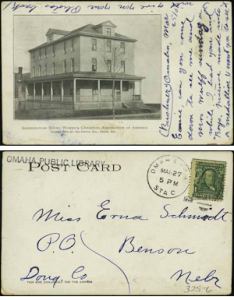 When looking at old postcards in Nebraska Memories have you noticed that some of them have writing on the front of the card or that there is a lot of white space around the picture on the postcard? This may be because in the early days people were not allowed to write a message on the back of the postcard next to the address.
When looking at old postcards in Nebraska Memories have you noticed that some of them have writing on the front of the card or that there is a lot of white space around the picture on the postcard? This may be because in the early days people were not allowed to write a message on the back of the postcard next to the address.
The Smithsonian Institution provides a nice history of postcards starting in 1861 when the US Congress passed an act that allowed privately printed cards to be sent in the mail.
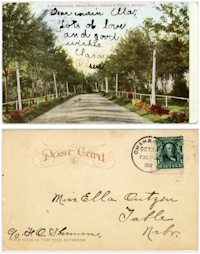 Later legislation passed in 1873 allowed the government to produce postcards with a message on one side and an address on the other side. These government postcards could be mailed for 1¢ however privately created postcards cost 2¢ to mail. In 1898 the prices were changeed so all postcards required just a 1¢ stamp. Other laws were enacted between 1898 and 1906 that changed the requirements on what information must be printed on the back of a postcard however; people were still not allowed to write a message on the back of the card next to the address.
Later legislation passed in 1873 allowed the government to produce postcards with a message on one side and an address on the other side. These government postcards could be mailed for 1¢ however privately created postcards cost 2¢ to mail. In 1898 the prices were changeed so all postcards required just a 1¢ stamp. Other laws were enacted between 1898 and 1906 that changed the requirements on what information must be printed on the back of a postcard however; people were still not allowed to write a message on the back of the card next to the address.
Americans were finally allowed to write on the backside of the postcards in 1907. According to the 1906 Post-Office Department Annual Reports for the Fiscal Year ended June 30, 1906, this change came about after the meeting of the Universal Postal Union that took place in Rome. After a bit of research, I learned that Universal Postal Union (UPU) is the international organization that sets the rules for international mail exchange. The UPU was established in 1874.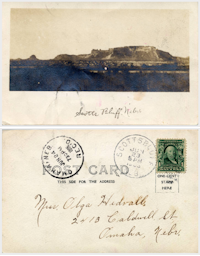
The change to allow writing on both sides of the card came about because of public request. Folks did not want to write a message on or next to the images on the front side of the cards. European countries were the first to make this change. Starting on October 31, 1906 the US Post Office started allowing postcards mailed from foreign countries to be delivered in the US with writing on the back. On March 1, 1907, the US Post Office allowed postcards mailed domestically to have written messages on the left side of the card next to the address. If you read the original text in the 1906 US Post Office report, you will see that they refer to the side of the postcard that contains the address to be the front of the postcard.
This period between 1901 and 1907, when folks were not allowed to write on the back of the postcard has become known as the Undivided Back Period. All of the postcards included in this post are from Nebraska Memories and examples from the Undivided Back Period. Looking at the back of these postcards, you will see that all of them contain a printed message that makes it clear that the only thing that can be put on the back of the postcard is the address.
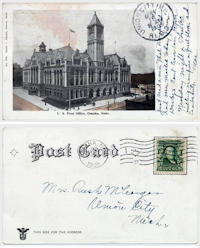 Visit Nebraska Memories to search for or browse through many more historical images digitized from photographs, negatives, postcards, maps, lantern slides, books and other materials.
Visit Nebraska Memories to search for or browse through many more historical images digitized from photographs, negatives, postcards, maps, lantern slides, books and other materials.
Nebraska Memories is a cooperative project to digitize Nebraska-related historical and cultural heritage materials and make them available to researchers of all ages via the Internet. Nebraska Memories is brought to you by the Nebraska Library Commission. If your institution is interested in participating in Nebraska Memories, see http://nlc.nebraska.gov/nebraskamemories/participation.aspx for more information, contact Devra Dragos, Technology & Access Services Director.
Nebraska Hall of Fame Newest Inductee Selected
 On August 2, 2017, the Nebraska Hall of Fame Commission selected Thomas Rogers Kimball, a Nebraska architect, as its newest inductee. The Nebraska Hall of Fame was established in 1961 to recognize prominent Nebraskans. As of 1998, only one person is added to the Hall of Fame every five years. Busts of Hall of Fame members are placed in the Nebraska State Capitol. An induction ceremony for Kimball will be planned in 2019.
On August 2, 2017, the Nebraska Hall of Fame Commission selected Thomas Rogers Kimball, a Nebraska architect, as its newest inductee. The Nebraska Hall of Fame was established in 1961 to recognize prominent Nebraskans. As of 1998, only one person is added to the Hall of Fame every five years. Busts of Hall of Fame members are placed in the Nebraska State Capitol. An induction ceremony for Kimball will be planned in 2019.
Thomas Rogers Kimball was born in Ohio in 1862 but moved to Omaha with his family when he was in his early teens. Kimball studied at the University of Nebraska then went on to study architecture at the Massachusetts Institute of Technology. In 1891, Kimball returned to Omaha and opened an office.
Kimball designed numerous buildings, many of which are still in use today. In Nebraska Memories, there are images of fourteen different buildings that Thomas Rogers Kimball designed. Here are few of the buildings you may recognize.
In addition to designing buildings, Kimball also served as an architectural adviser on numerous projects both in Nebraska and in other states. The two most notable projects in Nebraska included the Trans-Mississippi Exposition and the State Capitol. Rogers along with C. Howard Walker were co-architects-in-chief of the Trans-Mississippi Exposition and designed a few of the buildings. Kimball also served as an architectural advisor for Nebraska State Capitol Commission. He was involved in organizing the competition that lead to the design of the current Capitol.
Thomas Rogers Kimball died in September 1934 just after the Nebraska State Capitol was completed.
Visit Nebraska Memories to search for or browse through many more historical images digitized from photographs, negatives, postcards, maps, lantern slides, books and other materials.
Nebraska Memories is a cooperative project to digitize Nebraska-related historical and cultural heritage materials and make them available to researchers of all ages via the Internet. Nebraska Memories is brought to you by the Nebraska Library Commission. If your institution is interested in participating in Nebraska Memories, see http://nlc.nebraska.gov/nebraskamemories/participation.aspx for more information, contact Devra Dragos, Technology & Access Services Director.
Posted in Nebraska Memories, Technology
Leave a comment
A Fresh Perspective
Nebraska Memories contains thousands of images. Many of these images show buildings and street scenes from across the state. When the metadata that accompanies these images includes an address I like to find the location on a map. Finding the location on an online map is easy but since so many of the buildings have changed over the past 100+ years I don’t always find it helpful. When I saw the Library of Congress’s (LOC) announcement that they were providing access to nearly 25,000 Sanborn Fire Insurance Maps I was thrilled. At this time, the maps from sixteen states are available. Lucky for us one of those states in Nebraska. Currently all of the maps available were published prior to 1900.
If you’ve never seen a Sanborn Fire Insurance Map before they may seem a bit odd the first time you look at one. As the name implies, these maps were created for assessing fire insurance liability. On the maps, you will see the outline of buildings along with information about building materials, the number of doors and windows and the amount of hose available. If you need help understanding all of the abbreviations and symbols on the map like I did, I’d suggest you look at the LOC’s About this Collection page.
I started exploring the Sanborn maps by first picking a few photos in Nebraska Memories and then trying to locate them on one of the maps. As I looked at different places on the map, I realized how much information was available. That information combine with seeing how a building related to other structures around it provided me with a fresh perspective of images I’ve viewed multiple times.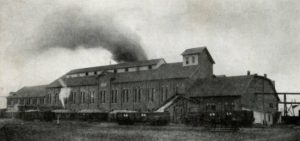
One photo that I selected was the Beet sugar factory, Grand Island, Neb. On the photo, note the two raised sections on the roof and the smoke that is rising from behind the building.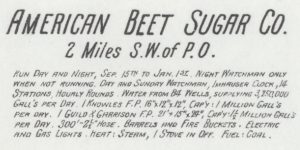 Now let’s look at the 1899 Sanborn Fire Insurance Map from Grand Island, Hall County, Nebraska. I found the American Beet Sugar Co. located on image 18 of the map. Under the name, it says, “2 Miles S. W. of P.O.”. The P.O. as you may have guessed stands for post office. I’ve included a screen shot of paragraph of information available on the map. As you read it, remember these are fire insurance maps.
Now let’s look at the 1899 Sanborn Fire Insurance Map from Grand Island, Hall County, Nebraska. I found the American Beet Sugar Co. located on image 18 of the map. Under the name, it says, “2 Miles S. W. of P.O.”. The P.O. as you may have guessed stands for post office. I’ve included a screen shot of paragraph of information available on the map. As you read it, remember these are fire insurance maps.
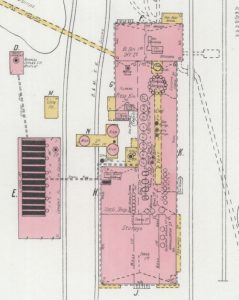 On the drawing of the building, do you see the yellow square with the long yellow rectangle below it? It looks like a yellow i in the middle of the building. If you zoom in on the original map image you can see the words “Tank on R’F.” next to the square and “Vent in R’F” next to the rectangle. Now look to the left of the main building and find the building with the think black lines and small circles. The black lines represent steam boilers. The circles are iron chimneys. The circle with the black dot in the middle is the fire pump. I’m assuming the smoke or steam that we see in the picture is coming from this building. Taking these three pieces of information and comparing it to the photo, I would guess this picture shows the east side of the factory. Looking at the map, you will see other features of the factory such as the “underground sluice” that connects the beet shed to the main building and the “Molasses Reservoir (underground) Wood Cover”. These maps were drawn to scale so we can see that the reservoir is huge. Other areas I noticed include washers, brushes, slicing machine, granulator, press room and lime slackers.
On the drawing of the building, do you see the yellow square with the long yellow rectangle below it? It looks like a yellow i in the middle of the building. If you zoom in on the original map image you can see the words “Tank on R’F.” next to the square and “Vent in R’F” next to the rectangle. Now look to the left of the main building and find the building with the think black lines and small circles. The black lines represent steam boilers. The circles are iron chimneys. The circle with the black dot in the middle is the fire pump. I’m assuming the smoke or steam that we see in the picture is coming from this building. Taking these three pieces of information and comparing it to the photo, I would guess this picture shows the east side of the factory. Looking at the map, you will see other features of the factory such as the “underground sluice” that connects the beet shed to the main building and the “Molasses Reservoir (underground) Wood Cover”. These maps were drawn to scale so we can see that the reservoir is huge. Other areas I noticed include washers, brushes, slicing machine, granulator, press room and lime slackers.
Next, I located the Union College campus on image 47 of the 1891 Sanborn Fire Insurance Map from Lincoln, Lancaster County, Nebraska. The Union College, Ella Johnson Crandall Memorial Library has a collection of 100+ images in Nebraska Memories so I knew there were many photos available.
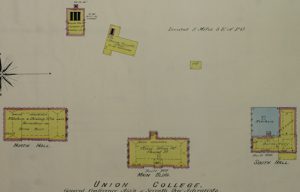 When you look at this map or any of the Sanborn maps, make sure you look for the compass rose on the map and locate north. At first I had assumed the top of the map was north but quickly learned that is not always true. The location of north can even change from one image to the next. If you look at the full version of the Union College map, you will see that north is to the left.
When you look at this map or any of the Sanborn maps, make sure you look for the compass rose on the map and locate north. At first I had assumed the top of the map was north but quickly learned that is not always true. The location of north can even change from one image to the next. If you look at the full version of the Union College map, you will see that north is to the left.
The map shows five buildings located on campus. There are images of the three largest building in Nebraska Memories. Because these three buildings have been torn down, this map gives us a better perspective on exactly where they were located in relationship to each other. Remember that these maps are drawn to scale.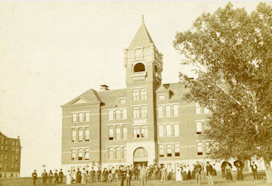
- Main Building or the Administration Building – It is located at the bottom center of the map. It’s noted on the map that it was built in 1891.
- North Hall – This building is located to the left or north of the admin building. A note on the map states that this hall is currently being built.
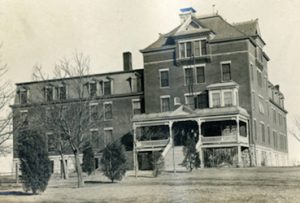
- South Hall – As you can guess, this building is to the right or south of the admin building. The map also notes that this building was built in 1891.
At the top left of the map is a building that is labeled “Bolier R’m 1st Laundry 2d” with the note “To Be Built as Shown”. There are two photos of the Union College laundry building in Nebraska Memories but the photos are from the 1940’s. I don’t have enough information to know if the building in the photo is the same building that is pictured on the map.
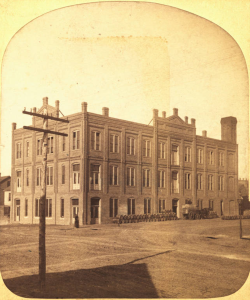 In the 1887 Sanborn Fire Insurance Map from Omaha, Douglas And Sarpy County, Nebraska I located the Garneau Cracker Factory on image 20. This building was located on the northwest corner of 12th and Jackson St. While it was interesting looking at the building and learning that they did the mixing on the 3rd floor and baking on the 2nd what really caught my eye was the last line in the blurb about the building. The line states “1 Doz. Hand Grenades”.
In the 1887 Sanborn Fire Insurance Map from Omaha, Douglas And Sarpy County, Nebraska I located the Garneau Cracker Factory on image 20. This building was located on the northwest corner of 12th and Jackson St. While it was interesting looking at the building and learning that they did the mixing on the 3rd floor and baking on the 2nd what really caught my eye was the last line in the blurb about the building. The line states “1 Doz. Hand Grenades”. 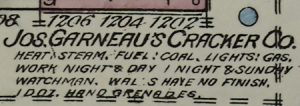 I must admit that I had to stop and think about that one for a few seconds until I remembered that this is a fire insurance map. Those hand grenades were actually fire extinguishers. They were glass containers that were filled with a chemical. You were supposed to throw them at the fire causing the glass to break and releasing the chemical. If you would like to know more about them, I found a newspaper story in the 1884 Pacific Rural Press that includes a picture and description.
I must admit that I had to stop and think about that one for a few seconds until I remembered that this is a fire insurance map. Those hand grenades were actually fire extinguishers. They were glass containers that were filled with a chemical. You were supposed to throw them at the fire causing the glass to break and releasing the chemical. If you would like to know more about them, I found a newspaper story in the 1884 Pacific Rural Press that includes a picture and description.
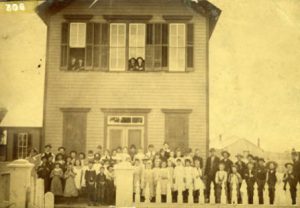 I must admit that not all of my attempts to locate buildings on a map were instantly successful. For example, the Cheyenne County Historical Society and Museum has a collection of 77 images in Nebraska Memories that cover a large span of time. In the LOC collection, there are two Sanborn maps for Sidney. One is from 1887 and the other is from 1892. Unfortunately, many of the buildings are not labeled with store names. I was able to find the First Sidney school on image 2 of the 1887 map. It’s located at the corner of 1st St. and Chestnut.
I must admit that not all of my attempts to locate buildings on a map were instantly successful. For example, the Cheyenne County Historical Society and Museum has a collection of 77 images in Nebraska Memories that cover a large span of time. In the LOC collection, there are two Sanborn maps for Sidney. One is from 1887 and the other is from 1892. Unfortunately, many of the buildings are not labeled with store names. I was able to find the First Sidney school on image 2 of the 1887 map. It’s located at the corner of 1st St. and Chestnut.
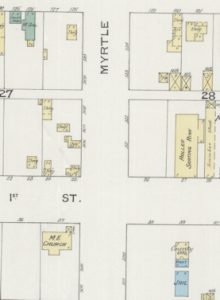 After looking at the Sanborn maps and a current map of Sidney, I’m starting to wonder if the street names have been changed. For example, the note included on the photo of the M.E. Church, Sidney, Nebr. states, “This church, built in 1919, replaced the Methodist Church built in 1884 on the same spot.” The record also states that the church is located at corner of 11th and Jackson Streets and currently is the Sidney Arts Center. I looked at a current map and was able to find the building located across the street from the county court house. On image 2 of the 1887 Sanborn Fire Insurance Map from Sidney, Cheyenne County, Nebraska I located a building labeled “M.E Church” that was also located across the street from a building labeled “County Offs.” These buildings were located at the corner of 1st St. and Myrtle. If I’m correct, that means 1st St. on the Sanborn maps is now Jackson St. and Myrtle is now 11th Ave. With a bit more work, I’m sure it would be possible to match more of the photos with buildings on the map.
After looking at the Sanborn maps and a current map of Sidney, I’m starting to wonder if the street names have been changed. For example, the note included on the photo of the M.E. Church, Sidney, Nebr. states, “This church, built in 1919, replaced the Methodist Church built in 1884 on the same spot.” The record also states that the church is located at corner of 11th and Jackson Streets and currently is the Sidney Arts Center. I looked at a current map and was able to find the building located across the street from the county court house. On image 2 of the 1887 Sanborn Fire Insurance Map from Sidney, Cheyenne County, Nebraska I located a building labeled “M.E Church” that was also located across the street from a building labeled “County Offs.” These buildings were located at the corner of 1st St. and Myrtle. If I’m correct, that means 1st St. on the Sanborn maps is now Jackson St. and Myrtle is now 11th Ave. With a bit more work, I’m sure it would be possible to match more of the photos with buildings on the map.
 I hope you enjoyed viewing these historical images, along with additional information available on the historical Sanborn maps. If you would like to do your own research there are plenty more images in Nebraska Memories and a long list of Nebraska Sanborn maps.
I hope you enjoyed viewing these historical images, along with additional information available on the historical Sanborn maps. If you would like to do your own research there are plenty more images in Nebraska Memories and a long list of Nebraska Sanborn maps.
Nebraska Memories is a cooperative project to digitize Nebraska-related historical and cultural heritage materials and make them available to researchers of all ages via the Internet. Nebraska Memories is brought to you by the Nebraska Library Commission. If your institution is interested in participating in Nebraska Memories, see http://nlc.nebraska.gov/nebraskamemories/participation.aspx for more information, contact Devra Dragos, Technology & Access Services Director.
Posted in Information Resources, Nebraska Memories, Technology
2 Comments
Miss Jessie M. Towne, D. O. G.
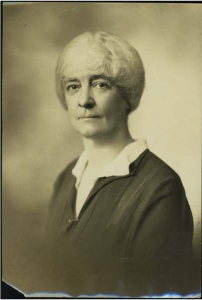 Whenever I see an antique portrait of a person either in an antique store or online, I always wonder who they were. With over 900 portraits in Nebraska Memories, there are plenty of them for me to wonder about. In Nebraska Memories, the amount of information that is provided about each person depends on many factors including where the photo came from and what information was written on or attached to the photo. I thought it might be fun to pick a portrait and see if I could learn more about the person. I looked at a few different portraits and decided to research Jessie M. Towne.
Whenever I see an antique portrait of a person either in an antique store or online, I always wonder who they were. With over 900 portraits in Nebraska Memories, there are plenty of them for me to wonder about. In Nebraska Memories, the amount of information that is provided about each person depends on many factors including where the photo came from and what information was written on or attached to the photo. I thought it might be fun to pick a portrait and see if I could learn more about the person. I looked at a few different portraits and decided to research Jessie M. Towne.
The portrait of Miss Jessie M. Towne is part of Omaha Public Library’s collection. The record for Miss Towne provided me with some great information to start my research. She worked at the Omaha Central High School for over 40 years retiring in 1930. She was a teacher, dean of girls and an assistant principal. I also learned that her father was Solon R. Towne. He was a health inspector and ornithologist.
I started my research by searching the US Census in the MyHeritage Library Edition database. (MyHeritage is a genealogy database that is available to all Nebraska residents at no cost through NebraskAccess.) Here is some of the information I found from looking at multiple censuses.
- Jessie was born in July 1874 in New Hampshire.
- Her parents were Dr. Solon R. Towne and Harriet C. Towne.
- Jessie was the oldest of four children.
- She had one younger brother Robert S. Towne.
- She had two sisters Mary A. Towne and Alice C. Towne.
- In the 1940 Census, both Jessie and Mary were single and living together at 1502 North 54 street in Benson, NE.
 Next, I searched another one of my favorite sites, the Library Of Congress’s Chronicling America: Historic American Newspapers collection. The first article I found was “High School Girls to have a “Foster Mother”.” It appeared in the July 4, 1915 issue of the Omaha Daily Bee and talked about how she was recently appointed D.O.G. D.O.G. stands for Dean of Girls. Miss Towne looks like a series women in both the portrait and the photo that was included in the article. The article, however, describes her as someone who laughs. “Miss Towne does not giggle. But she laughs with her whole person. Her face lights up and her big eyes dance with amusement, merriment and sometimes she rocks to and fro. She laughs with perfect freedom. She laughs with girlish glee.” The article was very amusing to read. I also learned that she had already been teaching at the high school since 1895.
Next, I searched another one of my favorite sites, the Library Of Congress’s Chronicling America: Historic American Newspapers collection. The first article I found was “High School Girls to have a “Foster Mother”.” It appeared in the July 4, 1915 issue of the Omaha Daily Bee and talked about how she was recently appointed D.O.G. D.O.G. stands for Dean of Girls. Miss Towne looks like a series women in both the portrait and the photo that was included in the article. The article, however, describes her as someone who laughs. “Miss Towne does not giggle. But she laughs with her whole person. Her face lights up and her big eyes dance with amusement, merriment and sometimes she rocks to and fro. She laughs with perfect freedom. She laughs with girlish glee.” The article was very amusing to read. I also learned that she had already been teaching at the high school since 1895.
An article that appeared in the June 23, 1915, issue of the Omaha Bee talks about how she was assigned the position of Dean of Students in addition to being the head of the English Literature department. With the addition of the new responsibilities, her salary was increased from $1,400 a year to $2,000 a year.
Another great source of information was the Omaha Central High School Archives that contains digitized copies of the school’s newspaper and yearbooks. Jessie was mentioned many times in both. Here are a few of my favorites.
- The February 1916 issue of The Register contains a picture of her as a small child. The picture and accompanying article can be found on page 14 of the PDF document or page 26 of the newspaper.
- In that same issue of the paper is a small article describing Miss Towne’s presentation to a group of Dundee ladies. According to the article, “She mentioned the new system of having some of the Senior girls wear purple and white ribbons so that the poor, bewildered little Freshmen might know whom to apply when in need of aid.” (Page 10 of the PDF document or page 16 of the newspaper.)
- “Gallant Harrie Sbearer Recuses Fair Maiden”. In the February 10, 1928, issue of The Weekly Register, there was an article describing how a ghost was stalking Miss Towne. In a second article, they tell about how Miss Towne jumped up on a seat to make an announcement and found herself unable to move. While the article implies that it might have been the ghost at work it turns out her shoe got caught in the seat. Her shoe came off when Harrie helped her down.
The Central High School Foundation has a short bio of Jessie on their website. Not only did Jessie teach at the school she also graduated from there in 1892. She took courses at Harvard, Stanford and graduated from the University of Nebraska. At some point in time, she was made vice principal.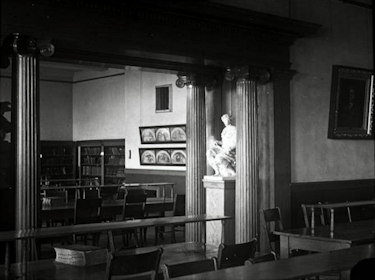
When Jessie attended and taught at the High School it had a much more formal feeling than I would expect to find at a school today. The photos in Nebraska Memories provide us with a glimpse of the ornate sculptures and artwork in the corridors and classrooms.
Even though I’ve already learned a lot about Jessie, I decided to do a couple of more searches. I’m happy I did because I found what I think is the most interesting piece of information. In 1913, Jessie presented at the nineteenth annual meeting of the Nebraska  Library Association. The article starts at the bottom of page 394 in Public Libraries, Volume 18. The article outlines the events of the two-day meeting that was held at the Omaha Public Library. Jessie presented a paper on the reading of high school students.
Library Association. The article starts at the bottom of page 394 in Public Libraries, Volume 18. The article outlines the events of the two-day meeting that was held at the Omaha Public Library. Jessie presented a paper on the reading of high school students.
The journal Libraries: A Monthly Review of Library Matters and Methods, Volume 19 provided a few more details about her presentation. Her paper was titled “Stimulation to reading for high-school students.” Her presentation and that of a coworker were “issued in pamphlet form by the Omaha public library.”
As I mentioned before Miss Jessie Towne retired in 1930. She passed away on July 8, 1957. She was survived by her sisters Miss Mary Towne of Omaha and Mrs. Fred Deweese of Lincoln.
While I was researching Jessie, I couldn’t help but find some information about her family. Here are few interesting tidbits of information that I found.
- Jessie’s father Dr. Solon R. Towne sounds like an interesting man. He served as president of both the Nebraska Audubon Society and the Nebraska Tuberculosis Association. You can read more about him in the article “Notes on Dr. Solon R. Towne and Early Bird Study in Omaha and Nebraska” in the April 1964 issue of The Nebraska Bird Review.
- Jessie’s mom Harriet was active in the Omaha Women’s Club and helped to start the Visiting Nurses’ Association in Omaha. You can see a photo of Harriet on page 3 of the document “The Omaha Visiting Nurses Association during the 1920s and 1930s”.
- I learned a bit about her sister Alice in the article “Physical Education for Women at Nebraska University, 1879-1923”. Alice attended and then worked at UNL. In 1908, she was appointed professor and director of the women’s gymnasium. The article contains two pictures of Alice.
Visit Nebraska Memories to search for or browse through many more historical images digitized from photographs, negatives, postcards, maps, lantern slides, books and other materials.
Nebraska Memories is a cooperative project to digitize Nebraska-related historical and cultural heritage materials and make them available to researchers of all ages via the Internet. Nebraska Memories is brought to you by the Nebraska Library Commission. If your institution is interested in participating in Nebraska Memories, see http://nlc.nebraska.gov/nebraskamemories/participation.aspx for more information, contact Devra Dragos, Technology & Access Services Director.
MyHeritage Library Edition Online Self-Paced Class
MyHeritage Library Edition is a genealogy database that contains more than five billion historical records from 48 countries including census and other government records, historical records, and photographs. MyHeritage is available to Nebraska residents at no cost through NebraskAccess.![]()
Have you wanted to explore this database, but haven’t made the time or didn’t know where to start? This class is designed to help you explore the resources available in MyHeritage at your own pace. The class consists of short lessons combined with quizzes that will require you to use MyHeritage to locate the answers.
This self-paced class is open to all Nebraska librarians and Nebraska public library board members. It will be available online from June 1 through June 30. You may begin the class at any point during the month of June, and you will have until the end of the month to complete it. This means you can complete the class in a few days or spread the lessons out over the month.
Class participants who are enrolled in the Nebraska Public Librarian or Public Library Board Certification program and who successfully complete all class lessons and quizzes by June 30th will earn 2 CE credit hours.
Register for the class at: http://nlc.nebraska.gov/scripts/calendar/eventshow.asp?ProgId=16259
Posted in Education & Training
Leave a comment
What are they?
Every time I see this image of the Burlington Shops in Nebraska Memories, I wonder what the gray things are piled up in front of the buildings.
Before asking for help identifying the items I had to do my own research. I’ve learned a lot about the Burlington Shops. I still don’t know what those items are but I have some better guesses now. Before I share my guesses and ask for your help, let me tell you what I’ve learned about the Burlington Shops in Havelock.
The book Lincoln: The Capital City and Lancaster County, Nebraska, Volume 1 (1916) provides a nice history of the town and the shops. The town of Havelock was incorporated on May 6, 1893. It was located about four 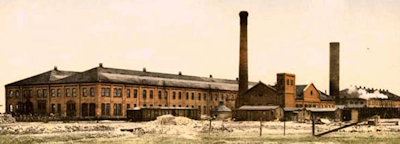 miles northeast of downtown Lincoln. Around the same time, Burlington decided to locate a repair and manufacturing shop in Havelock. Work on the first building started in June of 1890. A blacksmith shop, boiler shop and a new shop building were added a few years later. The next large expansion came 1910.
miles northeast of downtown Lincoln. Around the same time, Burlington decided to locate a repair and manufacturing shop in Havelock. Work on the first building started in June of 1890. A blacksmith shop, boiler shop and a new shop building were added a few years later. The next large expansion came 1910.
I was surprised by the amount of information I was able to find about the shops and expansion that took place around 1910. I found two journals articles published in 1911 that included detailed information about the Burlington Shops. At first glance, the articles may appear to be identical but they are slightly different. They contain too much information for me to include in this post but below are links to the articles along with few highlights.
- New Locomotive Repair Shops at Havelock, Neb. American Engineer and Railroad Journal, Volume 85
- Havelock Shops, Chicago, Burlington & Quincy R. R. Railway Master Mechanic, Volume 35
Here are a few highlights from these articles.
 Both articles provide detailed drawings of the property that includes the location and dimensions of every building. I found it fun to compare the map to a current bird’s eye view of the shops. Many of the builds are still being used today.
Both articles provide detailed drawings of the property that includes the location and dimensions of every building. I found it fun to compare the map to a current bird’s eye view of the shops. Many of the builds are still being used today.- The newly built storehouse is 80 ft. wide, 500 ft. long, and three stories high. It is surrounded on three sides by a 16 ft. wide platform.
- On the west end of the storehouse, 100 ft. of space on the first and second floors was designed as office space. On the first floor were “quarters of the superintendent of shops and the storekeeper. On the second floor are the stationer, medical examiner with emergency hospital fully equipped, telephone exchange, space for apprentice school and meeting room.”
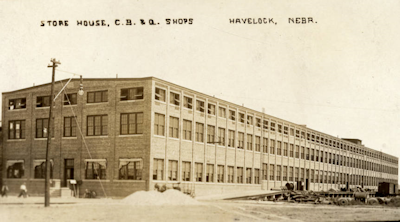
- The windows in the storehouse were designed to work with the material cases that would be stored in the building. “The material cases are 5 feet wide at the bottom and are separated by space of the same width. This arrangement gives a case spacing of 10 feet center to center and 7 feet of window between two adjacent cases, the tops of which are three feet wide.”
While both of these journal articles provided me with a ton of information, I still didn’t have any good guess about the objects in the photo. I thought they might be made out of cement because if you look at the bottom of a few of the stacks you can see that a few of them have broken. 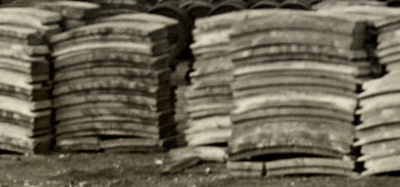
The article A Modern Concrete Slab and Pile Plant appeared in the 1921 issue of Railway Track and Structures, Volume 17 confirms that there was a concrete plant at the Havelock shops. The article listed some of the items manufactured at the Havelock Shops. “In addition to the concrete slabs and piles, the concrete plant is equipped to manufacture concrete fence posts, platform curbs, hog troughs and some miscellaneous items.” Included with the article was a picture of concrete curb units but they do not match the items in the picture.
Now that you know a bit more about the Burlington Shops at Havelock, what do you think the items are piled in front of the boiler shop? If you haven’t already done so, take a minute and go view the image on the Nebraska Memories website. You can use the zoom function to get a better view.
What do you think they are? As you can see, there are a few different items. I can pick out three different styles for sure.
 At the far left, you can see three small piles. I think they are flat but they do have slight curve to them.
At the far left, you can see three small piles. I think they are flat but they do have slight curve to them.
 In the middle of the picture are items that have a slight arch to them. If you look at the bottom of the piles, you can see a significant gap between the middle of the items and the ground. As I mentioned before a few of them have broken. Do you think these and the first items are both curbs used on curves?
In the middle of the picture are items that have a slight arch to them. If you look at the bottom of the piles, you can see a significant gap between the middle of the items and the ground. As I mentioned before a few of them have broken. Do you think these and the first items are both curbs used on curves?
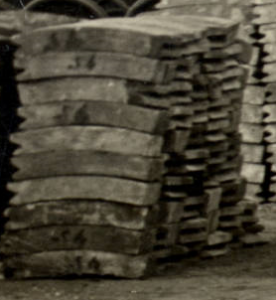 The items at the far right are much shorter. I think they have a slight arch to them. As I was looking at the picture of the roundhouse, I was wondering if these pieces could be used to line the turntable.
The items at the far right are much shorter. I think they have a slight arch to them. As I was looking at the picture of the roundhouse, I was wondering if these pieces could be used to line the turntable.
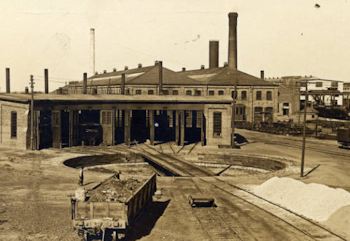 Do you agree with my guesses or am I completely off track? Are these pieces used in assembling a train engine? Leave me a comment and let me know what you think they are.
Do you agree with my guesses or am I completely off track? Are these pieces used in assembling a train engine? Leave me a comment and let me know what you think they are.
If you are interested in the Burlington shops, I found two additional historical journals articles that I read but didn’t reference in this post. I thought you might enjoy reading them.
- The Employment of Women in Railroad Shops
Railway Age Gazette, Volume 63 – 1917 - The Concrete Fence Post Factory of the C. B. & Q. R. R. Co., Havelock Neb.
Concrete-cement Age, Volume 6 – 1915
Visit Nebraska Memories to search for or browse through many more historical images digitized from photographs, negatives, postcards, maps, lantern slides, books and other materials.
Nebraska Memories is a cooperative project to digitize Nebraska-related historical and cultural heritage materials and make them available to researchers of all ages via the Internet. Nebraska Memories is brought to you by the Nebraska Library Commission. If your institution is interested in participating in Nebraska Memories, see http://nlc.nebraska.gov/nebraskamemories/participation.aspx for more information, contact Devra Dragos, Technology & Access Services Director.
Posted in Nebraska Memories
Leave a comment
Dense Fog Leads to Head-on Collision
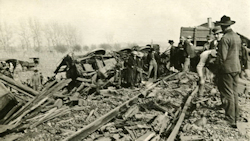 Sunday morning, November 22, 1908, two trains collided at Red Cloud killing two men. According to the article “Disastrous Wreck at Red Cloud” that appeared in the November 27, 1908 issue of The McCook Tribune, “two Burlington trains collided at the west end of the city stock yards at 6:55, doing great damage and killing two men and injuring one.”
Sunday morning, November 22, 1908, two trains collided at Red Cloud killing two men. According to the article “Disastrous Wreck at Red Cloud” that appeared in the November 27, 1908 issue of The McCook Tribune, “two Burlington trains collided at the west end of the city stock yards at 6:55, doing great damage and killing two men and injuring one.”
“The trains came together just beyond the yard limits, on a big curve, where there was a heavy fill, and the impact was so great that the engine 1225, pulling the extra from the west, was thrown from the track, as it struck 1182, 63’s engine, and was overturned and  fell almost bottom side up, killing the two men as she went over. Train 63 was standing still, and the force of the collision was so great that five cars, the tender and engine were badly wrecked, and three cars and the engine on the stock extra were reduced to kindling wood. The wrecking train was ordered from McCook and reached here about 1:30, and the work of cleaning the track was commenced in earnest, and was finally finished at 5:40 p. m., so that trains could go over the track.”
fell almost bottom side up, killing the two men as she went over. Train 63 was standing still, and the force of the collision was so great that five cars, the tender and engine were badly wrecked, and three cars and the engine on the stock extra were reduced to kindling wood. The wrecking train was ordered from McCook and reached here about 1:30, and the work of cleaning the track was commenced in earnest, and was finally finished at 5:40 p. m., so that trains could go over the track.”
There are six photos of this deadly wreck in Nebraska Memories taken by L. E. Tait. Basic information is written on the edges of each photo but the newspaper article provides more details.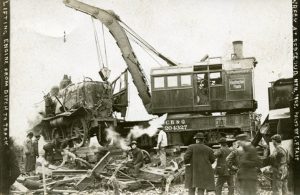 After reading the article, I think I was able to match the photos with the information provided in the newspaper article.
After reading the article, I think I was able to match the photos with the information provided in the newspaper article.
The photo labeled #1 shows the wrecking train, that came from McCook, lifting engine 1225. Engine 1225 was part of the stock train.
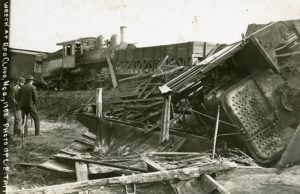 The photo labeled #2 shows two engines. I’m assuming the one at the top left of the photo is engine 1182. It was part of train No. 63. Along the right side of the photo is engine 1225. I know it’s somewhat hard to tell that this is an engine just by looking at this photo. If you compare the front end of the engine in photo #1 you can see that it matches the pile of metal on the ground.
The photo labeled #2 shows two engines. I’m assuming the one at the top left of the photo is engine 1182. It was part of train No. 63. Along the right side of the photo is engine 1225. I know it’s somewhat hard to tell that this is an engine just by looking at this photo. If you compare the front end of the engine in photo #1 you can see that it matches the pile of metal on the ground.
Photo #4 shows two men sitting on a pile of wreckage. Laying between them is a large axe. The man on the left is sitting on engine 1225, which is upside down.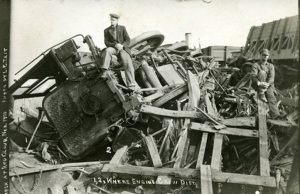 The paper said it “overturned and fell almost bottom side up, killing the two men as she went over.” The caption of the photo reads “1,2, Where Engine Crew Died”. If you look at the ground to the left and right of the engine, you will see the numbers 1 and 2 written on the picture. Killed in the accident were Engineer John W. Bartholoma and Fireman George Snoke. Short obituaries for both men can be found at the end of the newspaper article.
The paper said it “overturned and fell almost bottom side up, killing the two men as she went over.” The caption of the photo reads “1,2, Where Engine Crew Died”. If you look at the ground to the left and right of the engine, you will see the numbers 1 and 2 written on the picture. Killed in the accident were Engineer John W. Bartholoma and Fireman George Snoke. Short obituaries for both men can be found at the end of the newspaper article.
According to the newspaper article “The excitement was intense and more than 3,000 people visited the wreck, coming from Kansas and Nebraska towns for a radius of 20 miles, and most of them remained all day.” When I reading that line my first thought was that the newspaper article had to be exaggerating, that’s a lot of people. Looking closely at photo #6, I think the newspaper could be correct. Look at the huge groups of people on both sides of the track.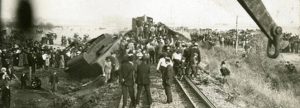
If you to read the complete newspaper article, you may have noticed that there was no reference to the dollar amount of damage caused by this wreck. While I was looking over the newspaper page that contained the article about the train wreck, I noticed the “Railroad News Items” along the left side of the page. Two items in this column relate to the wreck at Red Cloud.
- “The estimate of the total damages of last Sunday’s wreck is placed at near $20,000.”
- “The wrecking outfit came back from Red Cloud, Wednesday, and the engines – 1182 and 1225 – were started for Havelock, Thursday. The damage was estimated at over $4,000 on the two engines.”
Below the railroad news, you will find “Card of Thanks” from the Bartholoma and Snoke families.
I hope you enjoyed learning more about the C.B.&Q. (Chicago, Burlington & Quincy Railroad Company) train wreck at Red Cloud. Visit Nebraska Memories to search for or browse through many more historical images digitized from photographs, negatives, postcards, maps, lantern slides, books and other materials.
Nebraska Memories is a cooperative project to digitize Nebraska-related historical and cultural heritage materials and make them available to researchers of all ages via the Internet. Nebraska Memories is brought to you by the Nebraska Library Commission. If your institution is interested in participating in Nebraska Memories, see http://nlc.nebraska.gov/nebraskamemories/participation.aspx for more information, contact Devra Dragos, Technology & Access Services Director.
Posted in Nebraska Memories
Leave a comment
The Herpolsheimer Company
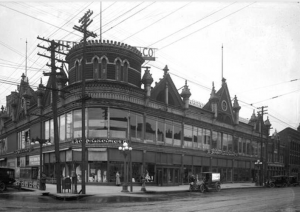 With Christmas just days away, many of us have been busy shopping for gifts. In the early days of Lincoln, residents had the choice of two department stores, Miller & Paine and Herpolsheimer’s. While Miller & Paine may be a name Nebraskan’s recognize I’m guessing most people don’t recognize the Herpolsheimer Company.
With Christmas just days away, many of us have been busy shopping for gifts. In the early days of Lincoln, residents had the choice of two department stores, Miller & Paine and Herpolsheimer’s. While Miller & Paine may be a name Nebraskan’s recognize I’m guessing most people don’t recognize the Herpolsheimer Company.
Henry Herpolsheimer first opened a dry goods store with Otto Mohrenstecher on O Street in downtown Lincoln. According to Lincoln historian Jim McKee, Henry built a new, 73,000-square-foot store at the corner of 12th and N Street in 1880. As you can see in the pictures of the building, there were large windows on the north side of the building. The store earned the nickname “The Daylight Store” because of the large windows and electric lights.
A window display of corsets was featured in the 1908 Dry Goods Reporter, Volume 38. According to the caption, the window was decorated by A. G. Sten. As a side note, if you are interested in photography note the article above the photo. It describes the steps you should take to get good photographs of display windows both during the day and at night. The night exposures could take up to thirty minutes.
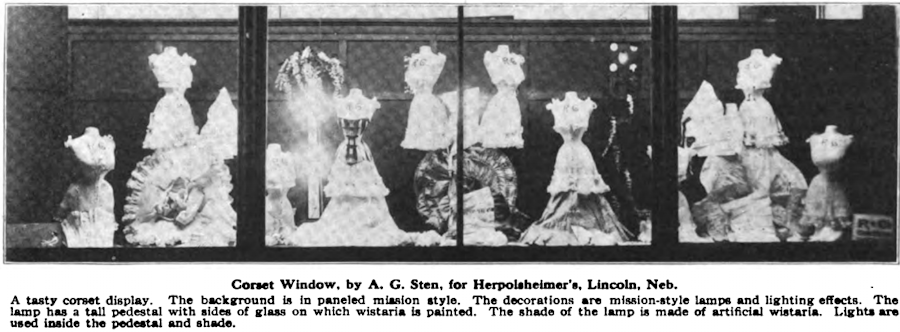
 Herpolsheimer’s sold a wide variety of goods. An ad in the January 28, 1893 issue of the Capital City Courier listed bedspreads, spreads and counterpaines for sale. The prices ranged from seventy-five cents up to $5.00.
Herpolsheimer’s sold a wide variety of goods. An ad in the January 28, 1893 issue of the Capital City Courier listed bedspreads, spreads and counterpaines for sale. The prices ranged from seventy-five cents up to $5.00.
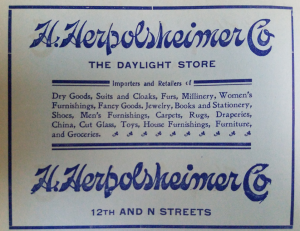 The ad for the H. Herpolsheimer Co. in the 1908 Lincoln Nebraska Directory (Jacob North & Company), lists many items for sale including dry goods, men’s and women’s furnishings, fancy goods, furs, toys and groceries.
The ad for the H. Herpolsheimer Co. in the 1908 Lincoln Nebraska Directory (Jacob North & Company), lists many items for sale including dry goods, men’s and women’s furnishings, fancy goods, furs, toys and groceries.
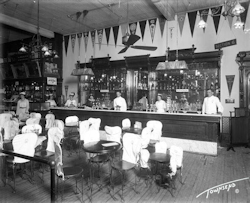 While I couldn’t find any information or advertisements for the soda fountain in the store, these 1914 photos show that they had one at that time. The signs on wall advertise items such as Dickinson’s Maple Mousse, a Mallow bitter sundae, Coca-Cola, and Vassar chocolates.
While I couldn’t find any information or advertisements for the soda fountain in the store, these 1914 photos show that they had one at that time. The signs on wall advertise items such as Dickinson’s Maple Mousse, a Mallow bitter sundae, Coca-Cola, and Vassar chocolates.
The Herpolsheimer Co. closed in 1931. I don’t know exactly when the building was torn down but by early 1939, a Firestone service station stood in its place at the corner of 12th and N. While there is still a Firestone station on that corner today, the original building was torn down and replaced in 1998.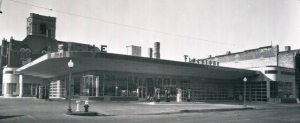
Visit Nebraska Memories to search for or browse through many more historical images digitized from photographs, negatives, postcards, maps, lantern slides, books and other materials.
Nebraska Memories is a cooperative project to digitize Nebraska-related historical and cultural heritage materials and make them available to researchers of all ages via the Internet. Nebraska Memories is brought to you by the Nebraska Library Commission. If your institution is interested in participating in Nebraska Memories, see http://nlc.nebraska.gov/nebraskamemories/participation.aspx for more information, contact Devra Dragos, Technology & Access Services Director.
Posted in General, Information Resources, Nebraska Memories, Technology
9 Comments
“The establishment of the town of Hastings was an afterthought…”

First National Bank – 2nd Street, West from Hastings Ave. As you can see in Google Street view, this building is still standing today.
“The establishment of the town of Hastings was an afterthought with the men who settled upon the three homesteads which formed the original parts of town.” I don’t know if that is true but that is what Henry G. Smith wrote in the Book of Hastings : a sketch of the town with illustrations. This book, published in 1906, is available in Nebraska Memories.
The Book of Hastings tells the history of the area starting in 1869. In 1873, the Hastings Town Company (page 6) was formed to develop the town of Hastings. On April 20, 1874, Hastings was declared an incorporated town.
Browsing this book, I learned a lot about the history of Hastings and the surrounding area. The book does not have a table of contents or an index, so I wanted to highlight some of the information available in this book.
- A number of railroads had service to or through Hastings over the years including the St. Joe & Grand Island, Burlington & Fremont, Elkhorn & Missouri Valley. (page 18)
- Juniata was selected as the county seat of Adams County in December 1871. Not everyone was happy with this. For years, folks fought to move the county seat to Hastings while others fought to keep it in Juniata.
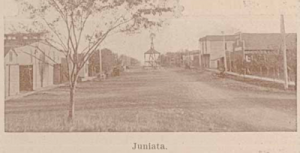
Juniata (page 81)
The group supporting Juniata won the 1875 election but lost the 1877 election. They were not happy with the loss and contested the vote. The issue was finally settled by Judge Gaslin. (page 22)
- A fire in 1879 destroyed 33 buildings in the Hastings business district. Many of the wooden buildings that burned were replaced with brick buildings. Later that year the Burlington depot was destroyed to cover up a murder. Fires in 1881, 1890, and 1905 also destroyed many businesses in town. (page 28)
- At the time this book was written, there were 18 church organizations in Hastings. A brief history of each organization is included. (page 40)
- The Hastings Library opened in January 1888. It was run by the Library Mite Society until it was taken over by the city government. In the spring of 1905 the new Carnegie building was completed. The library contained about 6,000 volumes. Miss Mabel Stone was the librarian. (page 46)
- Hastings residents started discussing the possibility of building a college in 1873 however, Hastings College did not become a reality until 1882. J. J. H. Hewitt was the first student to graduate in 1887. Dr. W. F. Ringland was the president of the college for the first 15 years. (page 70)
- Starting on page 81 you can find lists of many of the towns first officials including the mayor and councilmen.
- Towards the end of the book you will find a list of “Personal Sketches of Early Settlers” (page 95) followed by a list of businesses titled “Among the Business Houses” (page 103).
- The book is also full of pictures of houses however; most of them are only labeled with the name of the current resident.
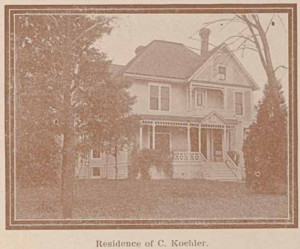
Residence of C. Koehler. (page 54)
I hope you take a few minutes to learn more about Hastings by looking at the Book of Hastings : a sketch of the town with illustrations.
Visit Nebraska Memories to search for or browse through many more historical images digitized from photographs, negatives, postcards, maps, lantern slides, books and other materials.
Nebraska Memories is a cooperative project to digitize Nebraska-related historical and cultural heritage materials and make them available to researchers of all ages via the Internet. Nebraska Memories is brought to you by the Nebraska Library Commission. If your institution is interested in participating in Nebraska Memories, see http://nlc.nebraska.gov/nebraskamemories/participation.aspx for more information, contact Devra Dragos, Technology & Access Services Director.
Hotel Fontenelle and Hotel Castle
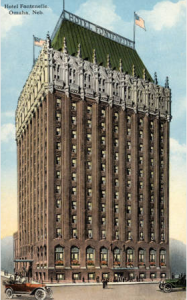 The first images the Hotel Fontenelle and Hotel Castle I saw were those included in Nebraska Memories. I didn’t know anything about the hotels and there wasn’t a lot of information about them included in Nebraska Memories. I decided to do a bit of research hoping to find a few interesting tidbits that I could share with you. I found more than just a few tidbits; I found what I consider to be a research jackpot. The Omaha Daily Bee newspaper did multiple page specials on both hotels when they opened. These special supplements are made up of multiple stories that tell about the hotels. Many of the companies that built, furnished and continued to work with the hotels also had advertisements in the supplements highlighting how they were connected to the hotels. These supplements were fun to read. I learned a lot about each hotel but it was also amusing to see what things were important to write about in 1915.
The first images the Hotel Fontenelle and Hotel Castle I saw were those included in Nebraska Memories. I didn’t know anything about the hotels and there wasn’t a lot of information about them included in Nebraska Memories. I decided to do a bit of research hoping to find a few interesting tidbits that I could share with you. I found more than just a few tidbits; I found what I consider to be a research jackpot. The Omaha Daily Bee newspaper did multiple page specials on both hotels when they opened. These special supplements are made up of multiple stories that tell about the hotels. Many of the companies that built, furnished and continued to work with the hotels also had advertisements in the supplements highlighting how they were connected to the hotels. These supplements were fun to read. I learned a lot about each hotel but it was also amusing to see what things were important to write about in 1915.
The Hotel Fontenelle opened in February 1915 on the corner of 18th and Douglas streets. It operated as a hotel until 1971 and was razed in 1983. The supplement covering the Hotel Fontenelle in the Omaha Daily Bee was published on February 28, 1915. The supplement is 15 pages long and was published in two sections. Both parts contain photos of the inside of the hotel.
Here are a few things in the article that caught my attention for one reason or another.
- “There are really sixteen stories in the Fontenelle – above the street. And there are two stories, very busy stories below the street. Total height, eighteen stories.”
- The architecture is Gothic. The first 10 stories are dark brick, above that is white tile and “the building design is of fretted and gabled French chateau style, with gabled roof painted a pleasing green.”
- The land cost $215,000.
- The land and building were owned by the Douglas Hotel Company. The supplement includes a list of officers and directors of the Douglas Hotel
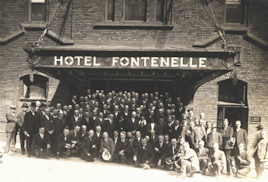 Company. The Interstate Hotel Company of Nebraska leased the hotel and ran it.
Company. The Interstate Hotel Company of Nebraska leased the hotel and ran it. - William R. Burbank was the director general of the hotel. Abraham Burbank was the managing director.
- The hotel has 350 guest rooms. The room rates varied depending on if they faced the street and the size and configuration of the room. The cheapest room listed was $2 a day while a corner suite that had a bedroom, bathroom and sitting room was $10 a day.
- “Sample rooms will rent at $2.50 up, according to size and location.” Traveling salesmen stayed at the hotel and used a sample room to display their products. The
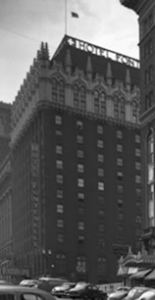 sample rooms were located on the tenth and eleventh floors. The rooms had thick carpeting, telephones and private toilet and bath rooms.
sample rooms were located on the tenth and eleventh floors. The rooms had thick carpeting, telephones and private toilet and bath rooms. - All of the rooms in the hotel had a telephone. Telephones were also placed in other locations such as the kitchen, barbershop, lobby and elevator. A very long article explains the 63 miles of telephone wire used and the switchboard could serve a town of about 3,000 people.
- Every room had “ice water on tap”. The water was “cooled to a temperature of forty degrees by ammonia coils” before being distributed through the building.
- The L. G. Doup Co. of Omaha provided the box springs and mattresses for the hotel. The mattresses were of the “very best quality — the hair used in the mattresses is long curled horse hair of the quality known as drawings…”
- “Big Electric Signs on top of New Hotel” – A short articles talks about the importance of the electric signs. “It is so built that it harmonizes with the
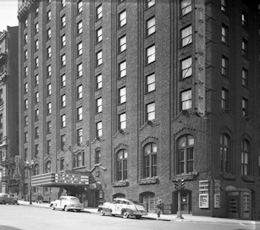 gable roof of the French chateau style of architecture.”
gable roof of the French chateau style of architecture.” - Included in the supplement are the floor plans for the ground floor and the main floor.
- “Hotel on Cow Stable Site” This column talks about the land the hotel was built on and how it was “far remote in the outskirts of a frontier country village fifty year ago; today the location of Omaha’s $1,000,000 modern and palatial hotel…”
- “Hotel Has Its Own Laundry” – I was surprised to read that the laundry was located on the 13th floor. “This is the only original motor driven laundry in Omaha. … big “extractors,” which turn on their vertical axes at a speed of a thousand revolutions a minute. These are for drying the wash. They remove the moisture by centrifugal force instead of by the slow and primitive process of drying.”

- Thomas R. Kimball was the architect for the hotel. According to the article, he was also the architect for the S. Cecelia’s cathedral, the Burlington station, designed the city library and the Methodist hospital.
- I’ve never heard of a telautograph but the Fontenelle had one. “A telautograph is an instrument that will reproduce your handwriting perfectly at a distance.”
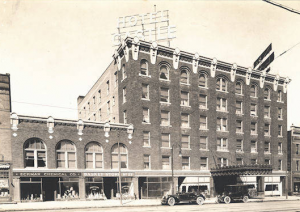 The Hotel Castle was located on corner of 16th and Jones Street and opened in March 1915. The main building was six stories high. The hotel had 150 rooms. All of the rooms had a toilet and running hot and cold water. One hundred of them also had private baths. Rooms rented for $1.25-$2 a day. Attached to the hotel is a two-story building referred to as the annex. The 50×80 feet convention hall or ballroom is located on the second floor of the annex.
The Hotel Castle was located on corner of 16th and Jones Street and opened in March 1915. The main building was six stories high. The hotel had 150 rooms. All of the rooms had a toilet and running hot and cold water. One hundred of them also had private baths. Rooms rented for $1.25-$2 a day. Attached to the hotel is a two-story building referred to as the annex. The 50×80 feet convention hall or ballroom is located on the second floor of the annex.
The special supplement about the Hotel Castle was published on March 21, 1915 in the Omaha Daily Bee. Here are some of things I found interesting about the Hotel Castle.
- “The Hotel Castle is absolutely fireproof. From basement to proof [sic] there is hardly a splinter in the construction that can be consumed by fire. The doors of the rooms are about the only inflamable things, the rest being concrete and marble.” Multiple times in the article, fireproofing is mentioned. This may seem odd at first but keep in mind that in 1913 a fire destroyed the Dewey Hotel killing around 20 people. If you would like to read about this fire there is an article about it in the Mach 1, 1913 issue of the Omaha Daily Bee.
- “even the smallest rooms have three lights,…and a third at the head of the bed so that guests can enjoy the luxury of reading in bed.”
- Miss Clara Fry was proprietor of the cigar stand. Miss Fry also owned a cigar stand in the Plains Hotel in Cheyenne Wyo.

- “Vinegar, pickles, olives, sauerkraut, ketchup and the like will be supplied to the new Castle by Haarmann Vinegar and Pickle Company…”
- The supplement contains a picture of a guest room and a bathroom and other rooms in the hotel.
- Yourex silverware was used at the hotel.
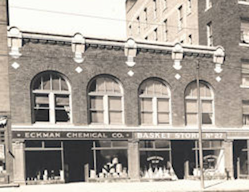
- “The Eckman Chemical Company was the first outside concern to rent one of the store buildings facing Sixteenth Street on the ground floor of the Castle.” According to their ad “If you have sick hogs, try Eckman’s special treatment for sick hogs.”
- If you need a laugh, I’d suggest reading the article “Some Guests to be Barred – Messrs. Rat, Mouse, and Bug and Their Families to Find No Homes Here.” It is a rather long article that tells the story of how Mr. Rat and his family were not able to find a place to live in the new Castle Hotel.
I hope you enjoyed learning about the Hotel Fontenelle and Hotel Castle.
Visit Nebraska Memories to search for or browse through many more historical images digitized from photographs, negatives, postcards, maps, lantern slides, books and other materials.
Nebraska Memories is a cooperative project to digitize Nebraska-related historical and cultural heritage materials and make them available to researchers of all ages via the Internet. Nebraska Memories is brought to you by the Nebraska Library Commission. If your institution is interested in participating in Nebraska Memories, see http://nlc.nebraska.gov/nebraskamemories/participation.aspx for more information, contact Devra Dragos, Technology & Access Services Director.
Posted in General, Nebraska Memories, Technology
1 Comment
Sometimes it is more than just a Nebraska Memories Blog Post
This week I had planned to write a short blog post highlighting some of the photos in Nebraska Memories taken 100 years ago in 1916. While I hadn’t actually typed a single character, mentally I had a great start on the post. That was until I did a quick web search on Spirella. That search started a chain of events that led to a bit of work and me deciding to revise the post I’d been mentally composing.
Here is the picture from 1916 that started my search. As you can see this image shows a room full of women sewing what looks like wide strips of fabric.
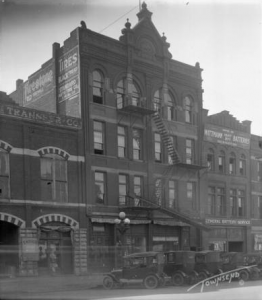 The Spirella Company was located at 211-215 S. 11th Street, Lincoln, Nebraska. The Library Commission’s office is located between 12th and 13th streets so this building would have been located about a block west. Unfortunately, the building was torn down but we do have a picture of the outside of the building taken in 1918.
The Spirella Company was located at 211-215 S. 11th Street, Lincoln, Nebraska. The Library Commission’s office is located between 12th and 13th streets so this building would have been located about a block west. Unfortunately, the building was torn down but we do have a picture of the outside of the building taken in 1918.
Don’t worry if you don’t recognize the name Spirella. Before starting this blog post, all I knew was that the Spirella Company made corsets and that in 1918 Ira B. Saunders was the General Manager of the plant.
A quick web search led me to the article in Wikipedia about Spirella. It provided me with a lot more information about Spirella and the twisted and flattened coils of wire used in the corsets. The Wikipedia article however was missing what I considered to be an important piece of information. There was no reference of the factory in Lincoln. How could that be, I was just looking at a picture of the factory.
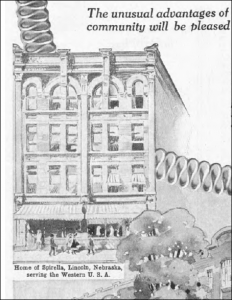 This is where the extra bit of work started. I knew I had to add the Lincoln location to the article but before I did, I wanted to do a bit of research to see if I could find any more information. The first thing I found that clearly confirmed that Spirella had a location in Lincoln was a one-page ad in the March 1917 issue of The Ladies’ Home Journal. The ad contained an image of the plant and stated, “At Lincoln, Nebraska, a plant was located to care for our clients west of the Mississippi.” The full ad is available online but I have included the image of the Lincoln building that was used in the ad. Did you notice that the top decorative triangle is missing? The curvy line to the top and left of the building is an image of the springs used in the corsets.
This is where the extra bit of work started. I knew I had to add the Lincoln location to the article but before I did, I wanted to do a bit of research to see if I could find any more information. The first thing I found that clearly confirmed that Spirella had a location in Lincoln was a one-page ad in the March 1917 issue of The Ladies’ Home Journal. The ad contained an image of the plant and stated, “At Lincoln, Nebraska, a plant was located to care for our clients west of the Mississippi.” The full ad is available online but I have included the image of the Lincoln building that was used in the ad. Did you notice that the top decorative triangle is missing? The curvy line to the top and left of the building is an image of the springs used in the corsets.
 In the 1917 issue of The American Federationist another ad mentions the Lincoln location. In the add it states “Spirella Corsets Are Made in Spirella’s Daylight Factories under Safe, Sanitary, Convenient, Working Conditions by well paid, contented, skilled works who find joy in their work.”
In the 1917 issue of The American Federationist another ad mentions the Lincoln location. In the add it states “Spirella Corsets Are Made in Spirella’s Daylight Factories under Safe, Sanitary, Convenient, Working Conditions by well paid, contented, skilled works who find joy in their work.”
While I had more than enough information to update the Wikipedia article I was still curious, so I did a quick search across the historic collection of newspapers available on the Library of Congresses’ Chronicling America: Historic American Newspapers website. While I didn’t find any information about the factory itself, I did learn a bit more about the corsets and the local corsetiere.
 Mrs. Magnolia Duke was a corsetiere in the North Platte area. There were numerous ads for her services in The North Platte semi-weekly tribune along with articles that mention her work. To the right is an example of one of those ads. This is from The North Platte semi-weekly tribune. (North Platte, Neb.) May 23, 1911, Image 8
Mrs. Magnolia Duke was a corsetiere in the North Platte area. There were numerous ads for her services in The North Platte semi-weekly tribune along with articles that mention her work. To the right is an example of one of those ads. This is from The North Platte semi-weekly tribune. (North Platte, Neb.) May 23, 1911, Image 8
In August of 1911, Magnolia traveled to Pennsylvania to attend the National Training School of Spirella Corsetieres. You can read about her trip in the article titled Home from Training School that appeared in the Sept. 1 edition of The North Platte semi-weekly tribune. (The article is at the top of the page, just to the right of the owls.)
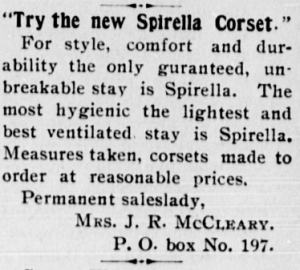 Another corsetiere in the state was Mrs. J. R. McCleary of Falls City. Here is her ad for corsets that appeared in the June 28, 1907 issue of The Falls City Tribune.
Another corsetiere in the state was Mrs. J. R. McCleary of Falls City. Here is her ad for corsets that appeared in the June 28, 1907 issue of The Falls City Tribune.
After gathering this information, I was able to update the Wikipedia article to include the factory in Lincoln. I also passed the information on to my colleague who added additional information to the photo in Nebraska Memories. As you can see, what I thought was going to be a simple blog post turned out to be a chance for me to correct wrong information and provided additional information to enhance our metadata in Nebraska Memories.
Visit Nebraska Memories to search for or browse through many more historical images digitized from photographs, negatives, postcards, maps, lantern slides, books and other materials.
Nebraska Memories is a cooperative project to digitize Nebraska-related historical and cultural heritage materials and make them available to researchers of all ages via the Internet. Nebraska Memories is brought to you by the Nebraska Library Commission. If your institution is interested in participating in Nebraska Memories, see http://nlc.nebraska.gov/nebraskamemories/participation.aspx for more information, contact Devra Dragos, Technology & Access Services Director.
Posted in General, Information Resources, Nebraska Memories, Technology
1 Comment
Dogs Rule and Cats Drool
A few weeks ago, I wrote a post titled “Cats Rule and Dogs Drool” that highlighted the cat photos in Nebraska Memories. I don’t want to offend dog lovers, so today’s post has gone to the dogs.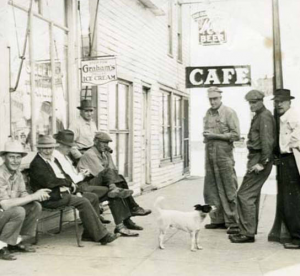
While I don’t know if any of the cats were drooling in the photos, I do know when comparing the number of cat pictures to dog pictures in Nebraska Memories that dogs definitely rule. There are only 11 photos of cats in the collection compared to 70+ photos that contain at least one dog. To be fair in a number of the photos the dog is not the center of attention and is just part of the crowd. This is true in this 1927? photo of a group of men and a dog standing in front of the Seefus Tavern and confectionary store in Valley, NE. In the description of the photo, you will find the names of all of the men, but the dog will forever be nameless.
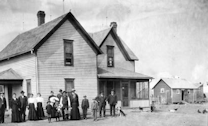 You can also find dogs included in
You can also find dogs included in 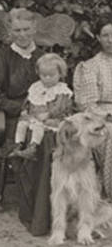 many of the family photos that were taken in front of the house. The Fred Schumacher family had at least two dogs that were included in their picture. Looking at the picture, I wonder if that white spot over by the chickens is a cat. The family in this photo, entitled People and dogs in front of sod house, included two large dogs in their photo. I wonder if the chicken was included on purpose or if it just wandered into the shot.
many of the family photos that were taken in front of the house. The Fred Schumacher family had at least two dogs that were included in their picture. Looking at the picture, I wonder if that white spot over by the chickens is a cat. The family in this photo, entitled People and dogs in front of sod house, included two large dogs in their photo. I wonder if the chicken was included on purpose or if it just wandered into the shot.
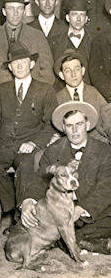 In other photos, dogs can be spotted front and center.
In other photos, dogs can be spotted front and center.  Th
Th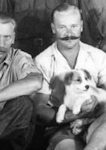 e man in the front row of this photo of the Crawford fire department is holding a dog sitting in the front row with him. The German prisoners of war at Camp Atlanta and the 1906 Nebraska State Normal School at Kearney football team also chose to include dogs in their group photos.
e man in the front row of this photo of the Crawford fire department is holding a dog sitting in the front row with him. The German prisoners of war at Camp Atlanta and the 1906 Nebraska State Normal School at Kearney football team also chose to include dogs in their group photos.
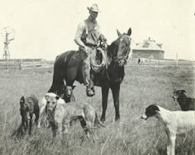 As you can see, some dogs were put to work. This man on a horse has a group of five dogs with him.
As you can see, some dogs were put to work. This man on a horse has a group of five dogs with him.
Have you ever seen a Dog walking on a tight rope? That was one well-trained dog.
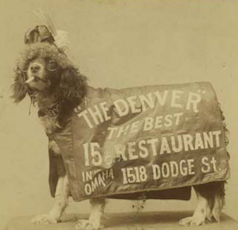 I don’t know what to say about this poor dog who was dressed up to advertise the Denver Chop House Restaurant in Omaha. To me the banner looks like it was designed for the dog to wear so he/she might have be used to that. Was the dog also trained to stand still wearing the wig, hat, and glasses? Do you think the dog actually had the cigarette in his mouth, or was it “photoshopped” in later? I asked a coworker this question, and she assumed it was really in the dog’s mouth because she didn’t realize people have been manipulating images since the 1800’s. You can see a few examples of manipulated photos in the, “What did it really look like?” blog post.
I don’t know what to say about this poor dog who was dressed up to advertise the Denver Chop House Restaurant in Omaha. To me the banner looks like it was designed for the dog to wear so he/she might have be used to that. Was the dog also trained to stand still wearing the wig, hat, and glasses? Do you think the dog actually had the cigarette in his mouth, or was it “photoshopped” in later? I asked a coworker this question, and she assumed it was really in the dog’s mouth because she didn’t realize people have been manipulating images since the 1800’s. You can see a few examples of manipulated photos in the, “What did it really look like?” blog post.
I’ve saved the cutest photos until the end. The Butler County Gallery collection in Nebraska Memories contains photos taken by the professional photographer Harvey Boston. As you can see, many people had pictures taken with their dog.
Visit Nebraska Memories to search for or browse through many more historical images digitized from photographs, negatives, postcards, maps, lantern slides, books and other materials.
Nebraska Memories is a cooperative project to digitize Nebraska-related historical and cultural heritage materials and make them available to researchers of all ages via the Internet. Nebraska Memories is brought to you by the Nebraska Library Commission. If your institution is interested in participating in Nebraska Memories, see http://nlc.nebraska.gov/nebraskamemories/participation.aspx for more information, contact Devra Dragos, Technology & Access Services Director.
Cats Rule and Dogs Drool

 According to my coworker, cats rule and dogs drool. I’m not sure I agree with him but don’t tell him that. He is one of many cat lovers who work at the Library Commission. If you work with a cat lover, are friends with a cat lover or are a cat lover yourself you probably see or are sent cute cat pictures and videos on a regular basis. The internet is full of cat related pictures and videos and social media has made it easy for folks to share their favorites.
According to my coworker, cats rule and dogs drool. I’m not sure I agree with him but don’t tell him that. He is one of many cat lovers who work at the Library Commission. If you work with a cat lover, are friends with a cat lover or are a cat lover yourself you probably see or are sent cute cat pictures and videos on a regular basis. The internet is full of cat related pictures and videos and social media has made it easy for folks to share their favorites.
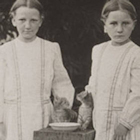 People taking pictures of their cats is nothing new. In Nebraska Memories, I found 11 photos that included at least one cat. Photographer John Nelson took pictures of his nieces Alice, Mildred, Eda and Henrietta all holding cats or kittens. You can’t go wrong with pictures of kids with cats.
People taking pictures of their cats is nothing new. In Nebraska Memories, I found 11 photos that included at least one cat. Photographer John Nelson took pictures of his nieces Alice, Mildred, Eda and Henrietta all holding cats or kittens. You can’t go wrong with pictures of kids with cats.
 John Nelson also took a picture of a cat in a hardware store. I find it amusing to see the cat sitting on top of the glass display case. I’m not sure if he intended for the cat to be the focus of the picture but the cat is more visible then the humans in the picture.
John Nelson also took a picture of a cat in a hardware store. I find it amusing to see the cat sitting on top of the glass display case. I’m not sure if he intended for the cat to be the focus of the picture but the cat is more visible then the humans in the picture.
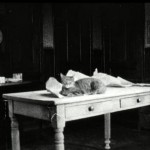 The other photos in Nebraska Memories that included cats were taken by William Wallace. William Wallace served as a vice president for the Omaha National Bank for many years, and it appears he was also an avid photographer.
The other photos in Nebraska Memories that included cats were taken by William Wallace. William Wallace served as a vice president for the Omaha National Bank for many years, and it appears he was also an avid photographer.
 It’s obvious that William meant for the cats to be the focus of his pictures. I’m guessing that the cats might have ruled the house. The cat looks content lying on the family’s kitchen table. Because the photos are black and white, it’s hard to tell if the cat on the table is also one of the cats sleeping on the bed. Do you think the cat on the bed
It’s obvious that William meant for the cats to be the focus of his pictures. I’m guessing that the cats might have ruled the house. The cat looks content lying on the family’s kitchen table. Because the photos are black and white, it’s hard to tell if the cat on the table is also one of the cats sleeping on the bed. Do you think the cat on the bed 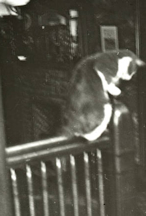 with the white fur on his face and neck is the same cat playing on the banister? Are they the same cats that are providing entertainment in these three pictures taken in the Wallace’s library?
with the white fur on his face and neck is the same cat playing on the banister? Are they the same cats that are providing entertainment in these three pictures taken in the Wallace’s library?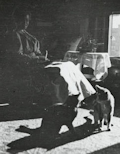
Visit Nebraska Memories to search for or browse through many more historical images digitized from photographs, negatives, postcards, maps, lantern slides, books and other materials.
Nebraska Memories is a cooperative project to digitize Nebraska-related historical and cultural heritage materials and make them available to researchers of all ages via the Internet. Nebraska Memories is brought to you by the Nebraska Library Commission. If your institution is interested in participating in Nebraska Memories, see http://nlc.nebraska.gov/nebraskamemories/participation.aspx for more information, contact Devra Dragos, Technology & Access Services Director.
It’s High School State Basketball Time
The Nebraska High School State Basketball tournaments are well under way in Lincoln. Last week the girl’s teams were in town for the championship games and this week the boy’s teams are here. Last night, as I watched the news coverage of the games, I wondered if there were any historical photos of high school basketball teams in Nebraska Memories. I was happy to find a few photos of basketball teams although I’m not sure they were all high school teams.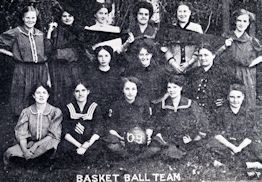
Two of the photos I located are of girls’ basketball teams. The first photo is of the 1909 Nebraska School for the Deaf (NSD) basketball team. Most the girls have a smile on their face and look happy to be having their picture taken. NSD was a school for students in kindergarten through 12th grade. It was located in Omaha from 1869 to 1998 when it closed.
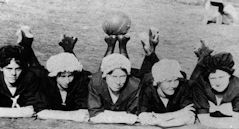 The second photo is of the Sacramento basketball team. I must admit that the first time I saw this photo I had to consult a map. I had no idea there was a town named Sacramento in Nebraska.
The second photo is of the Sacramento basketball team. I must admit that the first time I saw this photo I had to consult a map. I had no idea there was a town named Sacramento in Nebraska.
Today I think Sacramento it what some folks may refer to as a wide spot in the road. It is located about six miles southeast of Holdrege. According to the Nebraska State Historical Society, the town was established sometime between 1876 and 1878 with a population of around 200. School District No. 8 was located there from 1876-1952. While there was a school in town at the time this photo was taken in 1913, we don’t know if it was a school team.
I do have to admire the caps that the girls have on. Can you imagine all of the girls who played in the games last week wearing caps like that?
 In the Nebraska Memories collection, there are two photos of basketball teams from Loomis. One photo is from 1916 and the other is from 1918. According to the description of the photos Roland Bragg, Frank Johnston, and Gordon Linder appear in both photos. Again, I’m not sure if these are the high school basketball teams.
In the Nebraska Memories collection, there are two photos of basketball teams from Loomis. One photo is from 1916 and the other is from 1918. According to the description of the photos Roland Bragg, Frank Johnston, and Gordon Linder appear in both photos. Again, I’m not sure if these are the high school basketball teams.
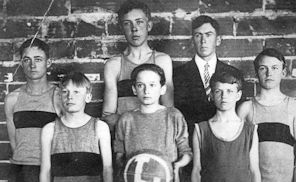 I thought some of the boys looked young so I did a quick search the 1910 US Federal Census for the boys. (Nebraskans can search this census and many other genealogy resources through the MyHeritage database, which is available through NebraskAccess.) I was easily able to locate Ronald and Reuben who were both 9 in 1910. I was also easily able to find Phil who was 10 and Gordon who was 11. That would make them 15, 16 and 17 in the 1916 photo.
I thought some of the boys looked young so I did a quick search the 1910 US Federal Census for the boys. (Nebraskans can search this census and many other genealogy resources through the MyHeritage database, which is available through NebraskAccess.) I was easily able to locate Ronald and Reuben who were both 9 in 1910. I was also easily able to find Phil who was 10 and Gordon who was 11. That would make them 15, 16 and 17 in the 1916 photo.
The last photo I want to highlight is that of the 1924 Bertrand High School basketball team. Unlike the girls from NSD these guys aren’t smiling. As you can see, they all have their arms crossed and most of them are trying to look tough.
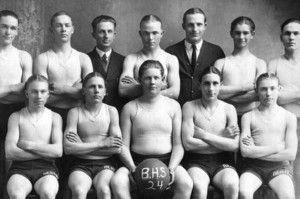 I was curious to see if this group of boys from Bertrand played in the Nebraska High School State Basketball tournament in 1924. I looked on the Nebraska School Activities Association’s (NSAA) website and found some historical information about the basketball championships. They have information for the boy’s teams going back to 1911 however; the information about the girl’s teams only goes back to 1977.
I was curious to see if this group of boys from Bertrand played in the Nebraska High School State Basketball tournament in 1924. I looked on the Nebraska School Activities Association’s (NSAA) website and found some historical information about the basketball championships. They have information for the boy’s teams going back to 1911 however; the information about the girl’s teams only goes back to 1977.
Here’s what I learned after reading the information on the NSAA’s site. In 1924 the boys state tourney was made up of 248 teams and they were divided into 16 classes. That year Bertand was in Class L. Assuming I’m reading the information correctly, Bertrand played in only one game against Papillion. They lost 11-12. Papillion then played Stockville and lost. Stockville then lost to Valley. In the last game Valley lost to Henderson. That made Henderson the 1924 Class L champions.
Do want to see more? Visit Nebraska Memories to search for or browse through many more historical images digitized from photographs, negatives, postcards, maps, lantern slides, books and other materials.
Nebraska Memories is a cooperative project to digitize Nebraska-related historical and cultural heritage materials and make them available to researchers of all ages via the Internet. Nebraska Memories is brought to you by the Nebraska Library Commission. If your institution is interested in participating in Nebraska Memories, see http://nlc.nebraska.gov/nebraskamemories/participation.aspx for more information, contact Devra Dragos, Technology & Access Services Director.
President’s Day
On the third Monday in February, the state of Nebraska celebrates President’s Day. The name of this holiday varies across the United States. While we call it President’s Day the federal government officially calls it Washington’s Birthday. It wasn’t until I read the Wikipedia article about Washington’s Birthday that I realized how many different names this holiday has been given. Some states celebrate both Washington’s and Lincoln’s birthdays and have named the holiday to include both of their names. Even those states that call it President’s Day disagree on the spelling. It is spelled Presidents’ Day, President’s Day, or Presidents Day depending on the state. No matter how you spell it I thought this would be a perfect time to highlight the images of three US Presidents that are included in Nebraska Memories.
President Benjamin Harrison was the 23rd President. He was in office from 1889-1893. If you would like to read more about President Harrison the White House website provides a nice biography on all of the Presidents. As you can see in the photo to the right, a large crowd of people turned out to see President Harrison on May 13, 1891 in downtown Omaha. If you would like to know more about this event, I suggest you do what I’m guessing many people did at that time and read about it in the newspaper. The Library of Congress’s project Chronicling America Historic American Newspapers provides access to many digitized newspapers from across the country. In the May 14, 1891 issue of the Omaha daily bee there are multiple articles telling about the six hours President Harrison spent in Omaha. You can read all about his visit on the Chronicling America website.
President Theodore Roosevelt was the 26th President. 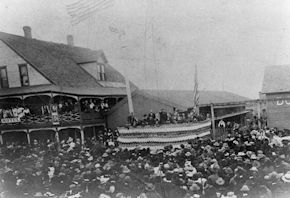 He was in office from 1901-1909. The picture at the left shows Roosevelt on October 1, 1900 in Holdrege. At this time, he was campaigning for the Vice Presidency. Roosevelt returned to Nebraska in 1912. The photos from Holdrege and Fremont both show Roosevelt standing on the back of a train car. I’m assuming these appearances were part of his campaign for the 1912 presidential election.
He was in office from 1901-1909. The picture at the left shows Roosevelt on October 1, 1900 in Holdrege. At this time, he was campaigning for the Vice Presidency. Roosevelt returned to Nebraska in 1912. The photos from Holdrege and Fremont both show Roosevelt standing on the back of a train car. I’m assuming these appearances were part of his campaign for the 1912 presidential election.
President William Howard Taft was the 27th President. He was in office from 1909-1913. 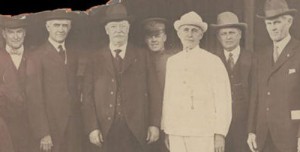 We have two photos of President Taft in Nebraska Memories. In this picture, he is standing with a number of prominent Omaha gentleman. Unfortunately, the exact date and location of this picture was never documented so we don’t know it was taken. The other picture shows the President riding in a car as part of a parade. We know that this picture was taken on September 21, 1909 at the inters
We have two photos of President Taft in Nebraska Memories. In this picture, he is standing with a number of prominent Omaha gentleman. Unfortunately, the exact date and location of this picture was never documented so we don’t know it was taken. The other picture shows the President riding in a car as part of a parade. We know that this picture was taken on September 21, 1909 at the inters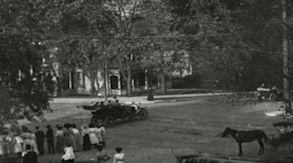 ection of 20th and Davenport Streets in Omaha. If you would like to read more about Taft’s visit the Omaha daily bee covered his visit.
ection of 20th and Davenport Streets in Omaha. If you would like to read more about Taft’s visit the Omaha daily bee covered his visit.
Visit Nebraska Memories to search for or browse through many more historical images digitized from photographs, negatives, postcards, maps, lantern slides, books and other materials.
Nebraska Memories is a cooperative project to digitize Nebraska-related historical and cultural heritage materials and make them available to researchers of all ages via the Internet. Nebraska Memories is brought to you by the Nebraska Library Commission. If your institution is interested in participating in Nebraska Memories, see http://nlc.nebraska.gov/nebraskamemories/participation.aspx for more information, contact Devra Dragos, Technology & Access Services Director
